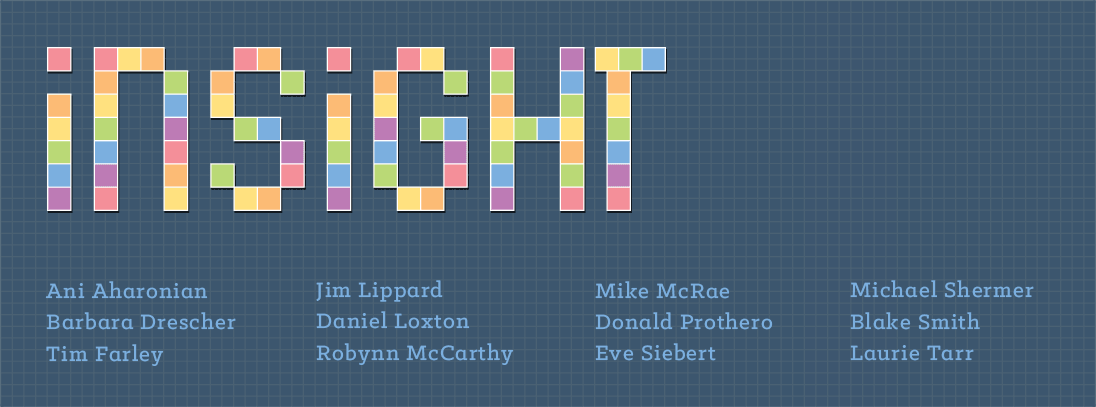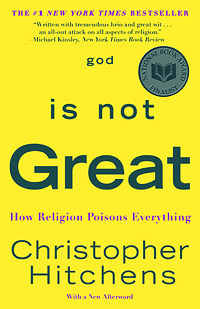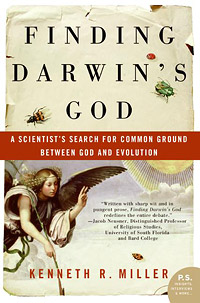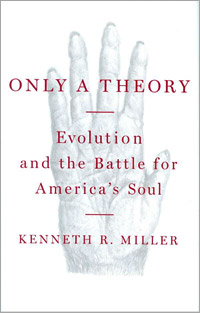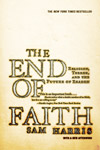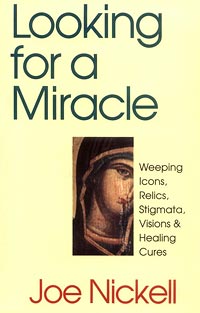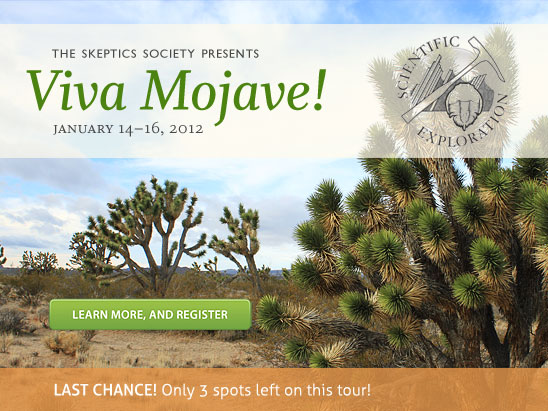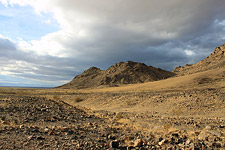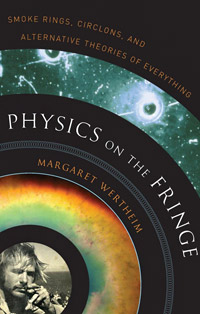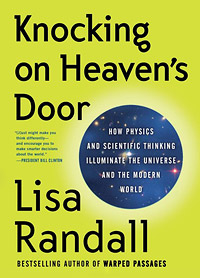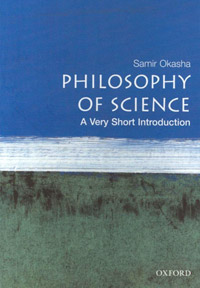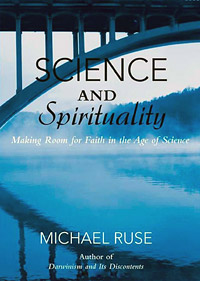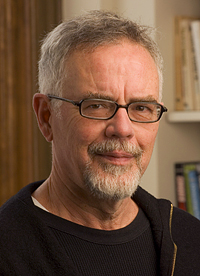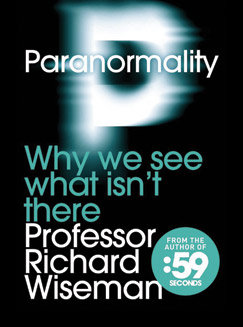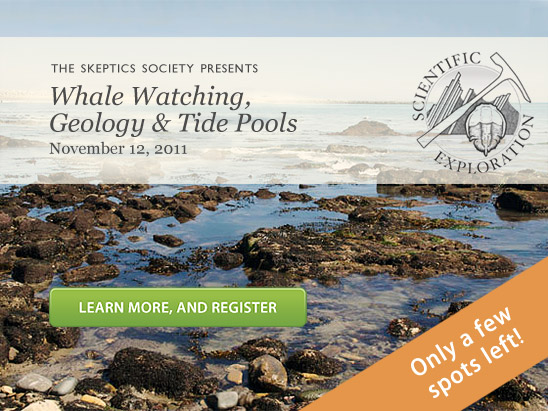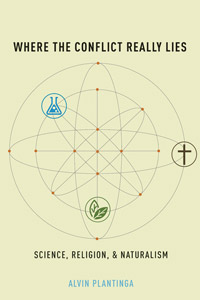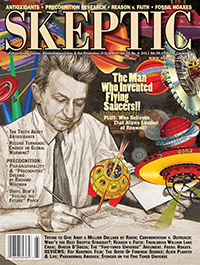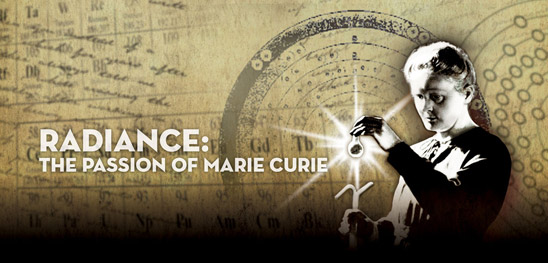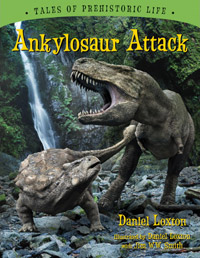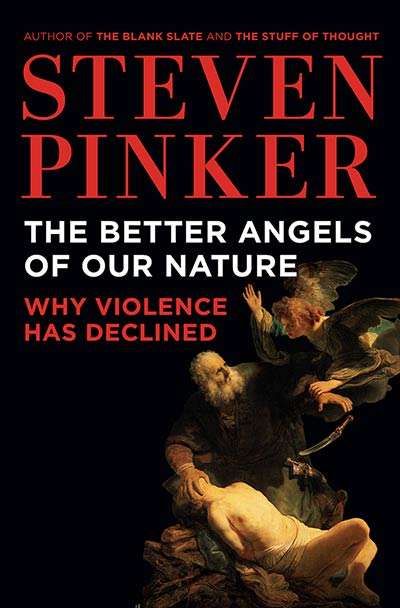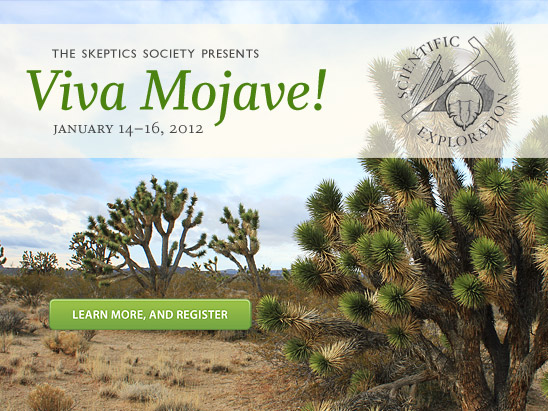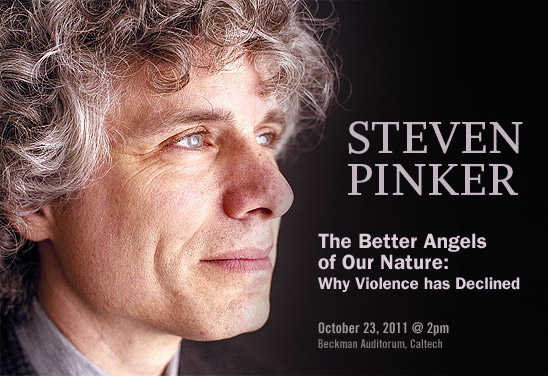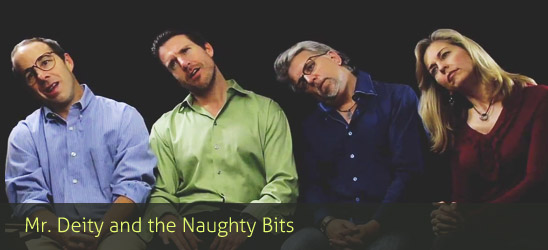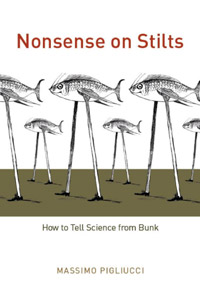12-01-11
In this week’s eSkeptic:
A DEBATE BETWEEN
Christopher Hitchens & Kenneth Miller on:
“Does Science Make Belief in God Obsolete?”
In last week’s eSkeptic, we presented Christopher Hitchens’ answer to the question “Does Science Make Belief in God Obsolete?” This week, we present the same question in the form of a debate between Christopher Hitchens and Kenneth Miller. Hitchens (self-proclaimed anti-theist and author of God Is Not Great) and Kenneth Miller (a pro-evolution Christian and author of Finding Darwin’s God) are worlds apart both by profession and belief, and yet both have brilliant minds for dissecting arguments both scientific and philosophical. First, Hitchens comments on Miller’s essay, followed by Miller’s response, and then the remaining dialogue between the two. This debate was edited by Michael Shermer for the Templeton Foundation’s Big Question Essay Series.
A debate between
Christopher Hitchens & Kenneth Miller
edited by Michael Shermer
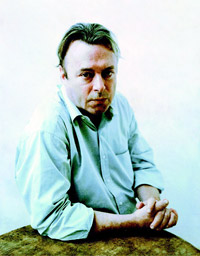
Christopher Hitchens (1949–2011). Photo by Christian Witkin.
Christopher Hitchens: I am not scientifically certified in any field, but when I read a “creationist” account of an Eden-based evolutionary fairy-story, I consider myself sufficiently qualified to understand and to refute the mental process by which it is argued. On the other hand, I do possess some small qualifications in the world of language and its relationship to cognition and I have to confess that I simply cannot make sense of a single one of your most important assertions or (perhaps I should better say) avowals.
What does it mean to say, “The Deity they reject so easily is not the one I know”? If you have such an extraordinary acquaintanceship, or source of information, is it only humility that keeps you confined in the small compass of Rhode Island? You go on to state that a rather intriguing and immense question (why is the world “bursting” with so much bio-diversity?) has in fact a rather obvious answer. You write: “To a person of faith, the answer to that question is God.”
Well, I hope I may be excused if I state that I already knew about the things that faith can apparently cause people—without a rag of evidence—to believe. But is this same reply also the answer to the question: “why have 99.9 per cent of all known species on our planet become extinct?” If so, then god—I don’t capitalize my concepts—explains everything and nothing with equal ease.
This same tenacious addiction to tautology and non-sequitur must be the explanation for the latter part of your essay, in which you accuse atheists of trying to make god “an ordinary part of the natural world” (no we don’t: the pantheists and the Paleyites do that). You make the circular assertion that god is “the reason for nature, the explanation for why things are” and the incoherent proposal that “He is the answer to existence, not part of existence itself.” I have heard Zen koans uttered with more articulation. It would be unkind to ask you how you proceed from such deistic assumptions to your theistic ones—the Resurrection, for example. Why do you believe in such things? Do you believe that you have a superior access to the numinous, and because such beliefs—in common with all other superstitions—are not subject to direct disproof or falsifiability? If so, you will, by the same token, have to accept my deeply-held belief that such opinions are the moral and verbal equivalent of white noise.
Before any further damage to the good name of science is done, let me point out that it is perfectly absurd to say that there is a “scientific faith” which assumes that all matters are reducible to the immediately comprehensible. I would briefly cite J.B.S. Haldane’s observation that the universe is not just queerer than we imagine, but queerer than we can imagine. I might add Einstein’s remark that the miracle is that there are no miracles: that the natural order is in fact harmonious and not to be interrupted by capricious supernatural interventions. If that doesn’t take care of deism, it takes care of theism—and it’s religion we are talking about in this debate. Professor Miller, you appear to me to fail the elementary test of being able to say what your opponents are talking about. But then, by your absurd use of the term “validate” in the closing sentence of your essay, you would seem to have no idea what you yourself are talking about, either.
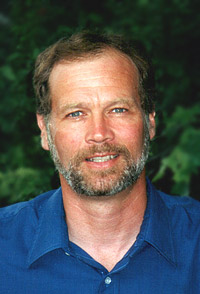
Kenneth Miller
Kenneth Miller: I must confess that I was surprised by the tone and the content of your writing, and especially by your eagerness to move the discussion away from science. You invoked history, writing that revelation came at the wrong time and to the wrong people. Apparently a proper God would have avoided “gaping peasants,” and delivered his message instead to high table at Oxford. You deliberately misread my reference to personal belief as a claim of special revelation, and even found time to ridicule a tiny American state—ironically, the very one which first gave birth to the concept of religious freedom. Why such departures from the issue at hand?
Perhaps it is because you sense the inherent weakness of your argument. Your essay cited three scientific points, which, you were confident, would have kept us from “adopting monotheism.” Ironically, in essence these were: 1) our species had a beginning, 2) the universe had a beginning, and 3) our existence will come to an end. Last time I looked, each of these was actually a teaching of the great monotheistic faiths. So much for the profound contradiction you sought.
You tip your hand when invoking extinction as a problem for faith, having fixed your arrow on nothing more sophisticated than an “Eden-based evolutionary fairy-story.” You declare yourself, just as young-earth creationists do, unable to stretch the cloth of Genesis around the Big Bang, mass extinction, and human evolution. But scripture reflects the flawed cosmology of its age, just as one might imprint today’s imperfect and incomplete science on the specifics of either your disbelief or my faith. Finding that old conceptions of nature are wrong, just as many of today’s theories surely are, does not even begin to invalidate the religious message that we live in a universe reflecting the will and rationality of a creator. You say that the natural order is harmonious. I agree. At issue is the source of that harmony.
You say that the grand sweep of the cosmos makes “pathetic nonsense” of the notion that human existence is part of a plan, but on what scientific basis do you make that judgment? In reality, the potential for human existence is woven into every fiber of that universe, from the starry furnaces that forged the carbon upon which life is based, to the chemical bonds that fashioned our DNA from the muck and dust of this rocky planet. Seems like a plan to me.
I was particularly impressed—but not in a good way—by your misuse of Einstein. In saying that there are “no miracles,” he was not ruling out the divine, but speaking to the scientific comprehensibility of nature. Einstein also said there are two ways to live: as though nothing is a miracle, or as though everything is. I choose the latter, and clearly, so did he. Finally, you say that I am an “opponent” who simply does not know what you are talking about. Mr. Hitchens, I regard you as a friend, not an opponent, and would suggest that the real problem is I understand what you are talking about all too well.
Hitchens: To take these points in reverse order: Albert Einstein took a Spinozist worldview that excluded the idea of a personal god or a deity that intervened in human affairs. The natural order does not respond to prayer or propitiation: it maintains its extraordinary regularity. This may not rule out a certain non-specific deism or pantheism, but it does make nonsense of the idea of a god to which human beings can address themselves.
The argument from design has seldom been stated more sloppily than in the “grand sweep” paragraph that (in ascending order) undergirds this misreading of Einstein. Pray tell, is it all designed, or just the apparently harmonious bits? The impending collision between our galaxy and Andromeda: part of the plan or not? A series of lifeless failed planets in our own solar suburb: good design or random coincidence? As with every other such invocation, the fans of the designer must convict him either of a good deal of waste and fumbling or a great deal of cruelty and indifference, or both.
It is cheap to compare me to a young-earth creationist just because I suggest that one must choose between “scripture” and science. The former does indeed reflect “the flawed cosmology of its age,” but that is precisely because it is a work of man and not a work of a deity. Which was my original point.
I cannot see how this insistence on an apparently designed harmony can be squared with your original assertion that god is “the answer to existence, not part of existence itself” or with your scorn for the idea that god is “an ordinary part of the natural world.” Is he or isn’t he the key to the natural order, or at any rate a dynamic element in it? I can understand you avoiding my question about resurrection, but if you want to stay focused on science then you can’t have this both ways.
It’s good of monotheists to accept that things have beginnings and ends. (“By god, sir,” as Samuel Johnson said in a slightly different connection, “they had better”.) I suppose one difference here is the eschatological one, or the way in which religion looks forward to the end. That important distinction to one side, the materialist view is simply that science can provide us, and indeed has provided us, with explanations for the origin and the terminus, of our cosmos and our species, that require no supernatural element. If this is not a scientific refutation of faith (which it isn’t, since faith isn’t susceptible to such procedures) it makes faith and science look increasingly hard to reconcile.
I was ridiculing you and not Rhode Island, as any careful reader will see. And yes, I do think that the Archangel Gabriel and the Virgin Mary and other apparitions ought at least once in human history to have shown themselves to people who were able to read and write, who were not terrified of demons and ghosts, and who possessed the ability to test evidence in the crucible of experiment. It hasn’t happened yet and I predict that it isn’t going to happen, either. Nonetheless, the witchdoctors and shamans can always count on the credulity of second-and-third-hand witnesses, descending to tenth-and-twentieth hand, some of whom will sadly claim to base their beliefs on scientific method.
Miller: You know, Christopher, I think we’re making progress. In your invocations of Einstein and Spinoza there is a grudging, if indirect, deference to the argument in my original essay—specifically, that faith “includes science, but then seeks the ultimate reason why the logic of science should work so well.” In each of your contributions to this dialogue, you’ve dismissed this as implying nothing more than deism, as if that alone was sufficient to refute it. As you well know, it is not.
Classic deism involves a God who is creator and prime mover, yet uninvolved in the affairs of his universe. But apply some logic here. By what principle would a God, capable of creating such vastness, be constrained from intervening in its affairs? Clearly, that restraint could only come by choice, and given such power, it would have to be a willing choice. The distinction between theism and deism, therefore, is really a claim about the personality of God, and the nature of his actions (or lack of same) in our created world. Earlier, I wrote that the atheist places God within the realm of science to investigate and test. The arguments you raise against scripture and reports of the miraculous take this form exactly, and that is also why they fall short—because they consider God to be a part of nature rather than nature’s cause. I do wonder what sort of God would meet your tests for clarity of teaching and evidence of existence, and I would love to hear your answer.
I accept that your first response was an attempt at personal ridicule. However, I wonder why you resort to such tactics if the logic of your case is so compelling. You note sarcastically that it is “good of monotheists to accept that things have beginnings and ends.” Can you possibly be serious, when Abrahamic monotheism has always spoken of ends and beginnings? As you acknowledge, science has indeed given explanations for “our cosmos and our species that require no supernatural element.” On that point you and I agree. But this means only that science has now confirmed nature’s sufficiency to fulfill the promised work of its creator.
You ask if all is designed, including galactic collisions, “failed planets,” and the extravagant waste of nature. Yet by what rubric do you know the “purpose” of galaxies and planets, in order to pronounce them “failed?” There is waste and death in nature and the cosmos, but there is something else as well. Amid the material from which you draw the bleak conclusion of purposeless chaos, there are the very laws and elements that make evolution (and humanity) possible. A great biologist, whom we both admire, once wrote that there was “grandeur in this view of life,” and science has done nothing since to set that judgment aside. A world of “endless forms, most beautiful and most wonderful” is the one in which we find ourselves, and I believe there is a reason for that.
Hitchens: That there might have been a “mind” at the beginning of the cosmos does not in the least entail that there still is one, or that its abstention from intervention in human affairs is conscious. (If the mind took the form of an intelligent and self-conscious “god”, as Lucretius pointed out, it would obviously wish to stay out of our petty quarrels and strivings.) And this mind would also need to have been created or inspired by still another mind, as in turn would that mind. No wonder that Christians prefer to start speaking about “mysteries” at this point.
Incidentally, are you a Christian? I have no idea which religion you do or do not believe in. Do you think that this eternal mind waited until two thousand years ago, then donated a son for a human sacrifice and thus enabled us to purge ourselves from sin? Or do you prefer to think that Mohammed is god’s messenger, or that the eternal mind has made a covenant with one special tribe? With atheists, it is always possible for our opponents to know and understand (if they choose to) what we believe (or do not believe). With religious people it is possible to spend a long time in discussion without ever discovering precisely what role they believe the supernatural to play in our lives. And no two claims are ever quite the same—further proof that the whole religious enterprise is improvised by primates.
To answer your challenge: if I had faith I would not presume to act or think as if god owed me an explanation. Surely that is the point of faith to begin with: to fill the unbridgeable void between evidence and the entire lack of it. That’s why I consider it the most over-rated of the virtues.
Miller: As we conclude, I am struck by your careful avoidance of our question—whether science makes belief in God obsolete. Instead you puzzle over my religion (I’m a Catholic) and invoke the old standbys: scripture is unreliable, faiths contradict, miracles are delusional fabrications, and God’s reported interventions in human affairs make no sense (to you). You dismiss a “mind” as first cause by invoking an infinite regression of minds—ironically unaware that your own view requires exactly that—an infinite regression of natural causes. A theist sees the logical problem here, but apparently you do not.
You avoided my direct question (to you, a “challenge”) of what might convince you of God’s reality. You wrote, in effect, that no evidence would do—a very fair summary of your views on this issue, I admit.
In the end you have no answer to why science works, why the physical logic of natural law makes life possible, or why the human mind is able to explore and understand nature. And I agree that there is no scientific answer to such questions. That is precisely the point of faith—to order and rationalize our encounters with the world around us. Faith is human, and therefore imperfect. But faith expresses, however poorly, a reality that includes the scientific experience in every sense, and therefore has become more relevant than ever in our scientific age. ![]()
Skeptical perspective on the Big Questions…
-
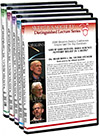 Origins & The Big Questions
Origins & The Big Questions
Conference 2008 (5 Part Set)
with Donald Prothero, Leonard Susskind, Paul Davies, Sean Carroll, Christof Koch, Kenneth miller, Nancey Murphy, & Michael Shermer -
Today, there is arguably no hotter topic in culture than science and religion, and so much of the debate turns on the “Big Questions” that involve “origins ”: the origin of the universe, the origin of the “fine-tuned” laws of nature, the origin of time and time’s arrow, the origin of life and complex life, and the origin of brains, minds, and consciousness. Now, science is making significant headway into providing natural explanations for these ultimate questions, which leaves us with the biggest question of all: “Does science make belief in God obsolete?” we have assembled some of the world’s greatest minds to discuss some of the world’s greatest questions. In 2008, the Skeptics Society held a conference wherein we assembled some of the world’s greatest minds to discuss some of the world’s greatest questions…
READ more about this conference and order the 5-part DVD set.
OR, order single DVDs: part 1 | part 2 | part 3 | part 4 | part 5
-
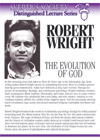 The Evolution of God
The Evolution of God
by Robert Wright -
From the Stone Age to the Information Age, Robert Wright unveils an astonishing discovery: there is a hidden pattern that the great monotheistic faiths have followed as they have evolved. Through the prisms of archaeology, theology, and evolutionary psychology, Wright’s findings overturn basic assumptions about Judaism, Christianity, and Islam, and are sure to cause controversy. He explains why spirituality has a role today, and why science, contrary to conventional wisdom, affirms the validity of the religious quest. And this previously unrecognized evolutionary logic points not toward continued religious extremism, but future harmony. READ more and order the DVD.
-
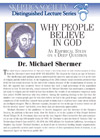 Why People Believe in God
Why People Believe in God
by Michael Shermer -
Shermer presents data from an empirical study of 10,000 Americans — why do people believe in God? Why is belief in God increasing, not decreasing as predicted? How the fact that we live in an age of science influences the reason people give for their faith. How people assume others believe in God for different reasons than they do. The psychology of rationalizing beliefs arrived at for non-rational reasons.
READ more and order the DVD.
Other Books & Lectures on Evolution & Creationism
Our online store has a wide selection of books and lectures (at Caltech) on the topics of evolution and creationism.

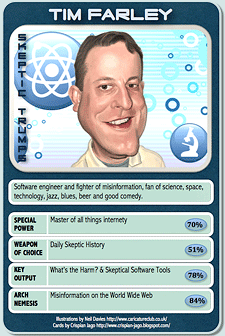
Tim Farley illustration by Neil Davies. Card design by Crispian Jago.
2011: A Year in Review
with Tim Farley
SKEPTICALITY EPISODE 173
This week on Skepticality, host Derek sits down with Tim Farley to reflect on what happened in the skeptical world over the course of 2011 and ponder what is in store for 2012. Tim Farley is the creator of the website Whats the Harm (a catalog of actual cases of people suffering physical, medical, financial or other harm because of their beliefs in concepts not supported by science) and Skeptic History (a collection of historical dates of interest to skeptics).
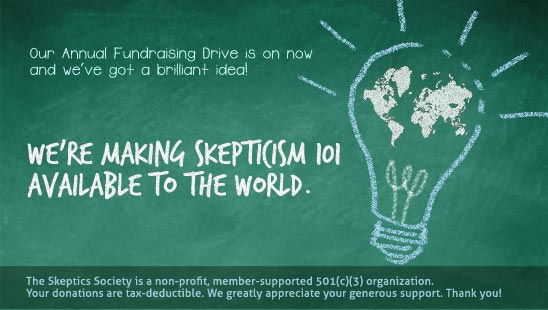
OUR ANNUAL FUNDRAISING DRIVE IS ON NOW
Help Send Skepticism 101 into the World!
- Click here to read our new plan to take Skepticism to the next level!
- Click here to make a donation now via our online store.
Monthly Recurring Donation Options Now Available
We encourage you to choose the monthly recurring donation option. Simply tell us how long you want your donation to recur (using the drop-down menu on the donation page) and we’ll set up automatic withdrawal for the amount you select.
Just for considering a donation, check out our free PDF download
created by Junior Skeptic Editor Daniel Loxton.
12-01-04
In this week’s eSkeptic:
- Junior Detectives Club : Free Skeptics Mix Tape “Bonus Track”
- Lectures at Caltech: Announcing Our Spring 2012 Lectures
- Follow Michael Shermer: God, Guns, and Artificial Intelligence
- Feature article: CHRISTOPHER HITCHENS on:
“Does Science Make Belief in God Obsolete?” - Fundraising Drive on Now: Skepticism 101 available to the world!
Junior Detectives Club —
Free Skeptics Mix Tape “Bonus Track”
TO START 2012 OFF RIGHT, we’re pleased to share a small gift from Junior Skeptic: the upbeat and apt song, “Junior Detectives Club” from science-themed children’s musician Monty Harper. We’ve added “Junior Detectives Club” as a bonus track for the the kid-friendly Skeptics Mix Tape 2009 project.
Harper recorded this song in 2007 for the Collaborative Summer Library Program (a reading program shared by many states) and for his album Get a Clue. “I wanted it to sound like a real club, singing a song to open their meeting,” Harper told eSkeptic. To achieve that sound, he enlisted the help of Oklahoma music teacher Rana McCoy and her children’s voice group, The Center Stage Singers.
The result is a light-hearted skeptical manifesto for kids, performed by kids—and it’s yours to enjoy.
Monty Harper writes award-winning children’s songs about science, reading, and creativity. His audiences laugh, clap, sing, wiggle, shout, roar, giggle, jump, hoot, pop, snap, and most of all… think! To learn more about Monty Harper visit his website, or check out his latest album, Songs From the Science Frontier, on iTunes.
Announcing the Spring 2012 Season
of Our Distinguished Lectures at Caltech
MARK YOUR CALENDAR! The Skeptics Society is pleased to announce another season of our Distinguished Lecture Series at Caltech.
All lectures are in Baxter Lecture Hall on a Sunday at 2 pm with the exception of the Monday, March 19 lecture which will be held at 7:30 pm and the Sunday, March 25 debate which will be held in Beckman Auditorium at 2 pm. All events include an author book signing. First up…
- Why We Believe in God(s): A Concise Guide to the Science of Faith
with Dr. Andy Thomson
Sunday February 12, 2012 at 2 pm - Abundance: Why the Future Will Be Much Better Than You Think
with Dr. Peter Diamandis
Saunday, February 26, 2012 at 2 pm - The Creative Destruction of Medicine: How the Digital Revolution
Will Create Better Health Care
with Dr. Eric Topol
Sunday, March 11, 2012 at 2 pm - Revelations: Visions, Prophecy, & Politics in the Book of Revelation
with Dr. Elaine Pagels
Monday, March 19, 2012 at 7:30 pm - The Great Debate: “Has Science Refuted Religion?”
Sean Carroll & Michael Shermer v. Dinesh D’Souza & Ian Hutchinson
Beckman Auditorium
Sunday, March 25, 2012 at 2 pm - Born Believers: The Science of Children’s Religious Belief
with Dr. Justin Barrett
Sunday, April 15, 2012 at 2 pm - Subliminal: How Your Unconscious Mind Rules Your Behavior
with Dr. Leonard Mlodinow
Sunday, April 29, 2012 at 2 pm - Consciousness: Confessions of a Romantic Reductionist
with Dr. Christof Koch
Sunday, May 13, 2012 at 2 pm - The Secrets of Mental Math: The Mathemagician’s Guide
to Lightning Calculation and Amazing Math Tricks
with Dr. Art Benjamin
Sunday, June 10, 2012 at 2 pm

NEW ON MICHAELSHERMER.COM
In the Year 9595
We have all heard about Watson, the computer that beat the two best champions on Jeopardy. But, how close are we to having computers emulate human though, become self-aware and take over the world? In this, the January Skeptic column for Scientific American, Michael Shermer ponders the question of artificial intelligence.
NEW ON SKEPTICBLOG.ORG
More God Less Crime, or More Guns Less Crime
During the last week of 2011, Michael Shermer spoke at and attended a salon in Santa Fe, New Mexico at which two of the speakers addressed the topic of the decline of crime, one (Byron Johnson) attributing it to god and the other (John Lott) to guns. In this week’s Skepticblog, Michael Shermer reports on their findings…
Christopher Hitchens on:
“Does Science Make Belief in God Obsolete?”
That was the Templeton Foundation’s Big Question in the third of a series of questions posed to leading scientist and scholars, among them: Steven Pinker, Victor Stenger, Mary Midgley, William D. Phillips, Christoph Cardinal Schönborn and Michael Shermer. In this week’s eSkeptic, we present Christopher Hitchens’ answer. Christopher Hitchens is the author of God Is Not Great. Hitchens died on December 15, 2011 at the age of 62. In tribute to Hitchens, we present this article which was edited by Michael Shermer for the Templeton Foundation’s Big Question Series. Tune in next week for a debate between Hitchens and Kenneth Miller (also part of the Big Questions Series).
No, But it Should
by Christopher Hitchens
Does science make belief in god obsolete? No, but it should. Until about 1832, when it first seems to have become established as a noun and a concept, the term “scientist” had no really independent meaning. “Science” meant “knowledge” in much the same way as “physic” meant medicine, and those who conducted experiments or organized field expeditions or managed laboratories were known as “natural philosophers.” To these gentlemen (for they were mainly gentlemen) the belief in a divine presence or inspiration was often merely assumed to be a part of the natural order, in rather the same way as it was assumed—or actually insisted upon—that a teacher at Cambridge University swear an oath to be an ordained Christian minister. For Sir Isaac Newton—an enthusiastic alchemist, a despiser of the doctrine of the Trinity and a fanatical anti-Papist—the main clues to the cosmos were to be found in Scripture. Joseph Priestley, discoverer of oxygen, was a devout Unitarian as well as a believer in the phlogiston theory. Alfred Russel Wallace, to whom we owe much of what we know about biogeography and natural selection, delighted in nothing more than a session of ectoplasmic or spiritual communion with the departed.
And thus it could be argued—though if I were a believer in god I would not myself attempt to argue it—that a commitment to science by no means contradicts a belief in the supernatural. The best known statement of this opinion in our own time comes from the late Stephen Jay Gould, who tactfully proposed that the worlds of science and religion commanded “non-overlapping magisteria.” How true is this on a second look, or even on a first glance? Would we have adopted monotheism in the first place if we had known:
- That our species is at most 200,000 years old, and very nearly joined the 98.9 percent of all other species on our planet by becoming extinct, in Africa, 60,000 years ago, when our numbers seemingly fell below 2,000 before we embarked on our true “exodus” from the savannah?
- That the universe, originally discovered by Edwin Hubble to be expanding away from itself in a flash of red light, is now known to be expanding away from itself even more rapidly, so that soon even the evidence of the original “big bang” will be unobservable?
- That the Andromeda galaxy is on a direct collision course with our own, the ominous but beautiful premonition of which can already be seen with a naked eye in the night sky?
These are very recent examples, post-Darwinian and post-Einsteinian, and they make pathetic nonsense of any idea that our presence on this planet, let alone in this of so many billion galaxies, is part of a plan. Which design, or designer, made so sure that absolutely nothing (see above) will come out of our fragile current “something”? What plan, or planner, determined that millions of humans would die without even a grave-marker, for our first 200,000 years of struggling and desperate existence, and that there would only then at last be a “revelation” to save us, about 3,000 years ago, but disclosed only to gaping peasants in remote and violent and illiterate areas of the Middle East?
To say that there is little “scientific” evidence for the last proposition is to invite a laugh. There is no evidence for it, period. And if by some strenuous and improbable revelation there was to be any evidence, it would only argue that the creator or designer of all things was either (a) very laborious, roundabout, tinkering and incompetent and/or (b) extremely capricious and callous, and even cruel. It will not do to say, in reply to this, that the lord moves in mysterious ways. Those who dare to claim to be his understudies and votaries and interpreters must either accept the cruelty and the chaos or disown it: they cannot pick and choose between the warmly benign and the frigidly indifferent. Nor can the religious claim to be in possession of secret sources of information that are denied to the rest of us. That claim was, once, the prerogative of the Pope and the witch-doctor, but now it’s gone. This is as much as to say that reason and logic reject god, which (without being conclusive) would be a fairly close approach to a scientific rebuttal. It would also be quite near to saying something that lies just outside the scope of this essay, which is that morality shudders at the idea of god, as well.
Religion, remember, is theism not deism. Faith cannot rest itself on the argument that there might or might not be a prime mover. Faith must believe in answered prayers, divinely-ordained morality, heavenly warrant for circumcision, the occurrence of miracles or what you will. Physics and chemistry and biology and palaeontology and archaeology have, at a minimum, given us explanations for what used to be mysterious, and furnished us with hypotheses that are at least as good as, or very much better than, the ones offered by any believers in other and inexplicable dimensions.
Does this mean that the inexplicable or superstitious has become “obsolete”? I myself would wish to say no, if only because I believe that the human capacity for wonder neither will nor should be destroyed or superseded. But the original problem with religion is that it is our first, and our worst, attempt at explanation. It is how we came up with answers before we had any evidence. It belongs to the terrified childhood of our species, before we knew about germs or could account for earthquakes. It belongs to our childhood, too, in the less charming sense of demanding a tyrannical authority: a protective parent who demands compulsory love even as he exacts a tithe of fear. This unalterable and eternal despot is the origin of totalitarianism, and represents the first cringing human attempt to refer all difficult questions to the smoking and forbidding altar of a Big Brother. This of course is why one desires that science and humanism would make faith obsolete, even as one sadly realizes that as long as we remain insecure primates we shall remain very fearful of breaking the chain. ![]()
Skeptical perspective on faith and spirituality…
-
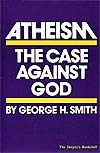 Atheism: The Case Against God
Atheism: The Case Against God
by George Smith
-
 The Soul of Science
The Soul of Science
by Michael Shermer -
Can we find spiritual meaning and purpose in a scientific worldview? Yes! There are many sources of spirituality; religion may be the most common, but it is by no means the only. Anything that generates a sense of awe may be a source of spirituality. Science does this in spades. READ more and order the book.
-
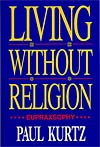 Living Without Religion
Living Without Religion
by Paul Kurtz -
One of America’s foremost expositors of humanist philosophy, Paul Kurtz shows how we can live the good life filled with morality, commitment, and dedication, without having to depend on the existence of a higher being. Drawing upon the disciplines of the sciences, philosophy, and ethics, Kurtz also offers concrete recommendations for the development of the humanism of the future. READ more and order the book.

OUR ANNUAL FUNDRAISING DRIVE IS ON NOW
We need your support!
- Click here to read our new plan to take Skepticism to the next level!
- Click here to make a donation now via our online store.
Monthly Recurring Donation Options Now Available
We encourage you to choose the monthly recurring donation option. Simply tell us how long you want your donation to recur (using the drop-down menu on the donation page) and we’ll set up automatic withdrawal for the amount you select.
Just for considering a donation, check out our free PDF download
created by Junior Skeptic Editor Daniel Loxton.
11-12-28
In this week’s eSkeptic:

OUR ANNUAL FUNDRAISING DRIVE IS ON NOW
We need your support!
- Click here to read our new plan to take Skepticism to the next level!
- Click here to make a donation now via our online store.
Just for considering a donation, check out our free PDF download
created by Junior Skeptic Editor Daniel Loxton.
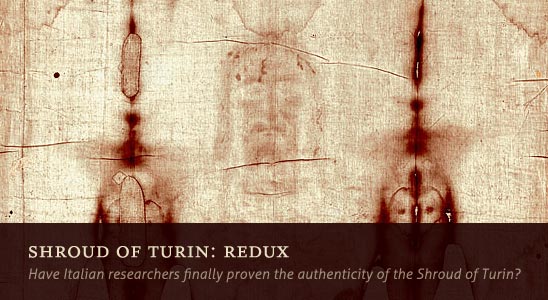
About this week’s eSkeptic
Recently, global headlines have resurrected the decades-old case of the Shroud of Turin in response to a group of Italian researchers who have studied its authenticity and claim that the image it bears (ostensibly of Jesus) was not faked. Though the case for fraud has indeed been strong since the 14th century, skeptics know all too well that some topics just never seem to get laid to rest. In this week’s eSkeptic, Daniel Loxton responds to the media hype.
Shroud of Turin: Redux
by Daniel Loxton
Skeptics sometimes express impatience with discussion of seemingly quaint paranormal claims. (“What, Bigfoot—again?”) But the great lesson of paranormal history is that it is a wheel: no matter how passé or fringe a claim may sound, it is almost guaranteed to come ‘round again, in the same form or in some novel mutation.
In the last few days, global headlines have resurrected a nostalgic case from my childhood, just in time for Christmas: “The Shroud of Turin Wasn’t Faked, Italian Experts Say.” The cutting edge of yesterday—today! Even in my youth, this mystery was centuries old.
The Shroud of Turin is a 14-foot length of linen cloth that bears a stylized picture of a bearded man. Legend holds the Shroud to be a burial cloth wrapped around the Biblical Jesus following his execution. This linen was allegedly flash-imprinted with an image of Jesus during his miraculous resurrection, presumably by an intense burst of energy released under such circumstances.
The case for fraud has been strong since the 14th century, but enthusiasts insist on rolling that wheel ‘round again. According to news reports this week, Italian scientists used an infrared CO2 laser to scorch images onto cloth and ”conducted dozens of hours of tests with X-rays and ultraviolet lights” in an effort to prove that the image could be created by a burst of electromagnetic energy. (Here’s a PDF of their Italian-language report.) What is the wavelength of a resurrection miracle? If there is one, the scientists were unable to discover what it might be. They learned (in ABC News’s paraphrase) that “no laser existed to date that could replicate the singular nature of markings on the shroud.”

Full-length photograph of the Shroud of Turin which is said to have been the cloth placed on Jesus at the time of his burial. (Public domain image from Wikimedia Commons.)
All this business with lasers is neither here nor there. I’m reminded of magician James Randi’s line from Flim-Flam! about the pseudoscience technique of the Provocative Fact.
The same technique was used by the Gellerites when they assured us that at no time did Uri Geller use laser beams, magnets, or chemicals to bend spoons. This was quite true. It is also quite true that he had no eggbeaters, asbestos insulation, or powdered aspirin in his pockets either. So what?1
Turns out it’s hard to make a Shroud copy using lasers. That’s hardly surprising, but neither is it relevant. There was never a good reason to think the Shroud was created by anything but the tools and artistry of a painter. Failed attempts to replicate the Shroud image using lasers only underline the argument skeptics have made for decades: the object is a medieval fake.
The bottom line on the Shroud remains the same: the Shroud continues to fail several key practical tests, as discussed by skeptical investigator Joe Nickell in his classic work on the subject, Looking for a Miracle:2
- Provenance: there is no sign that this object existed before the 14th century;
- Art history: the Shroud fits into art history as part of a genre of artistic depictions and recreations of burial cloths of Christ;
- Style: the image upon the shroud looks like a manufactured illustration consistent with 14th century religious iconography, not like a real human being;
- Circumstance: a 14th century Catholic bishop determined that the Shroud was a “cunningly painted” fraud—and discovered the artist who confessed to creating it;
- Chemistry: the Shroud contains red ochre and other paint pigments;
- Radiometric dating: carbon-14 dating tests showed in 1988 that the Shroud was likely created between 1260 and 1390 CE. In 2008, the hypothesis that this date was distorted by carbon monoxide contamination was tested—and results of the original tests confirmed.
Overturning the robustly supported conclusion that the Shroud was manufactured by a medieval artist would take extraordinary levels of evidence in favor of some alternate explanation. The current media hype carries no such breakthrough news. The opposite is true, in fact: the Italian researchers concede (as quoted by Vatican Insider) that their “inability to repeat (and therefore falsify) the image on the Shroud makes it impossible to formulate a reliable hypothesis on how the impression was made.”
After decades of controversy, the real shame is not merely the miasma of pseudoscience surrounding the relic (that’s a fog skeptics are happy enough to cut through) but the blurring of the lines between science and metaphysics—or if you like, between science and faith. The Shroud’s popularity seems to stem from the hope that it could deliver tangible evidence for the divine, but that hope is misplaced. Even if Shroud researchers were to prove their (exceptionally unlikely) speculation that the Shroud image was imprinted by “a short and intense burst of VUV directional radiation,” this would in no way confirm the existence of God, only of a unique printing process—a process enthusiasts have thus far been unable to demonstrate. The truth is that the tools and methods of empirical science would remain powerless to confirm the existence of a transcendent metaphysical God even in the event that such a being existed. It’s just not the sort of question science can answer.
Pressing science into the service of metaphysics may do harm to religion—I’ll leave it to the religious to say if that is so—but it cuts out the heart of the scientific enterprise. And that is a Christmas present that none of us should want.![]()
References
- Randi, James. Flim-Flam! (Prometheus Books: Amherst, New York, 1982.) p. 129
- Nickell, Joe. Looking for a Miracle. (Prometheus Books: Amherst, New York, 1998.) pp. 22–29
Skeptical must-haves for your library…
-
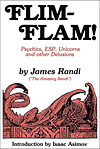 Flim Flam! Psychics, ESP, Unicorns
Flim Flam! Psychics, ESP, Unicorns
and other Delusions
by James Randi
-
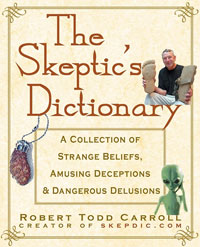 The Skeptic’s Dictionary
The Skeptic’s Dictionary
by Robert Carroll
-
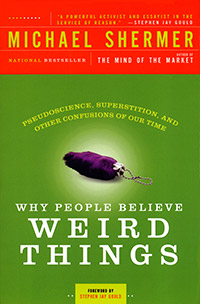 Why People Believe Weird Things: Pseudoscience, Superstition, and Other Confusions of Our Time
Why People Believe Weird Things: Pseudoscience, Superstition, and Other Confusions of Our Time
by Michael Shermer -
In this age of supposed scientific enlightenment, many people still believe in mind reading, past-life regression theory, New Age hokum, and alien abduction. A no-holds-barred assault on popular superstitions and prejudices, Why People Believe Weird Things debunks these nonsensical claims and explores the very human reasons people find otherworldly phenomena, conspiracy theories, and cults so appealing… READ more and order the book.
Viva Mojave!
Only 3 spots left for Viva Mojave!
JOIN THE SKEPTICS SOCIETY FOR A WONDERFUL THREE-DAY TOUR of the highlights of the Mojave Desert and the Las Vegas area. We will stop at the historic restored ghost town of Calico and take several tours, visit Afton Gorge where Ice Age floods drained Lake Manix, collect 550 million year old trilobites, experience the spectacular boulders of Red Rock Canyon, and conclude with a guided tour of Hoover Dam.
Click an image to enlarge it.
What’s Included?
Tour price includes charter bus, all hotel accommodations, breakfast and lunch each day, guided tour narration and guidebook, all other admission fees, and a tax-deductible contribution to the Skeptics Society of $130. Seats are limited to about 50 people on a single tour bus, so the tour should fill up fast.
Questions?
Email us or call 1-626-794-3119 with a credit card to secure your spot.
5 Free Junior Skeptic Cryptid Cards
Download and print 5 Cryptid Cards created by Junior Skeptic Editor Daniel Loxton. Creatures include: The Yeti, Griffin, Sasquatch/Bigfoot, Loch Ness Monster, and the Cadborosaurus. CONTINUE READING THIS POST…
TAGS: cryptozoology, free download11-12-21

It is Time Again to Support
Your Skeptics Society!
THE SKEPTICS SOCIETY is a non-profit, member-supported 501(c)(3) organization whose goal is to promote skeptical thinking (i.e. thinking like a scientist). Your generous support helps us continue our educational outreach through venues such as:
- Our international quarterly magazine SKEPTIC
(including Junior Skeptic inside every issue) - Our website, podcasts, Facebook, and Twitter
- Our Distinguished Lecture Series at Caltech
- Media interviews on national TV, radio, and in national paper
(opinion editorials, commentaries, and reviews) - University and college lectures
- Michael Shermer’s monthly column in Scientific American
- Skepticblog (with top skeptical writing talent), and
- Our free, weekly email newsletter, eSkeptic.
We’re Taking Skepticism into the Classroom!
This fall semester (2011) Michael Shermer has been teaching a course for Freshmen at Chapman University entitled “Skepticism 101: How to Think like a Scientist (Without Being a Geek).” Students are instructed to write a 700-word OpEd essay, deliver an 18-minute TED talk, and conduct an experiment testing a paranormal claim. They are reading many classic skeptical books and each week Shermer lectures on a classic skeptical topic such as: science and pseudoscience • science and religion • science and morality • evolution and creationism • the Baloney Detection Kit • how science works • Big Foot and Loch Ness, aliens and UFOs, Bermuda Triangle and Atlantis, etc.
Your Donations Will Help Put Skepticism into Schools & Teach Students How to Think, Not Just What to Think
Shermer’s “Skepticism 101” course is a pilot course for the development of a Skeptical Studies Curriculum that can be used in any classroom anywhere in the world, from middle school to high schools, and community colleges to universities. We are building a free, comprehensive online resource center dedicated to Skeptical Studies that will allow anyone, anywhere, anytime, to access for free any and all materials they might need to teach such a class of their own design, including:
- Syllabi, reading lists, articles
- Essays, lectures and notes, PowerPoint/Keynote presentations
- Videos, YouTube links, educational and entertaining in-class demonstrations on how to teach skeptical principles and the psychology behind them with hands-on experiences
- Other teaching tools that visually illustrate key points of skeptical thinking on how science works and how thinking goes wrong.
We have already begun collecting hundreds of submissions from teachers around the world as result of our initial invitation to submit skeptical course syllabi. With your help we can put Skepticism 101 resources on the web—a free, easy access location for educators wanting to introduce a particular topic to a class or to develop an entire course. To that end please take a moment to donate and support this worthy project.
Free Cryptid Cards (for considering a donation)
As our thank you to you for your generous support, we are offering a free download of 5 Cryptid Cards created by Junior Skeptic Editor Daniel Loxton. Loxton won the prestigious Lane Anderson Award for the best Canadian science book of the year for young readers: Evolution: How We and All Living Things Came to Be, a work that generated enormous media coverage, including the fact that the book was rejected by American publishers for being too controversial because it deals with the “E” word! As the Globe and Mail noted:
Daniel Loxton, an illustrator and writer, created a children’s book so outrageous, so outlandish, so controversial no American publisher dared touch it. It does not depict nudity. It does not contain curse words. It does not include blasphemy. The love scenes, such as they are, involve males with females. It does include a straightforward explanation for the complexity of the natural world through a simple scientific theory. The book wound up being published by Canadian-owned Kids Can Press, which also expected objections from creationists. So far, the book, an illustrated primer written for readers in Grades 3 to 7, has generated more prize nominations than controversy.
For contributions that fit a donation amount below,
you are eligible to receive the associated gift(s).
- PATRON—$5000 or more
- A private dinner with our Executive Director Michael Shermer at a restaurant of your choice, plus the three premium gifts listed below.
- BENEFACTOR—$1,000 or more
- Five of the “Greatest Hits” lectures from our Caltech lecture series on DVD: Mr. Deity & Friends, Michio Kaku’s The Physics of the Future, Sean Carroll’s From Particles to People, Leonard Mlodinow’s The Grand Design, and Sam Harris’ The Moral Landscape, plus the two premium gifts below.
- SPONSOR—$500 or more
- A copy of Jared Diamond’s latest book, Natural Experiments of History, plus Daniel Loxton’s new book, Ankylosaur Attack, for kids aged 4 to 7 with stunningly realistic images of dinosaurs and deceptively simple but information- packed scientifically accurate story, plus the premium gift below.
- SUPPORTER—$100 or more
- An autographed copy of Michael Shermer’s new book, The Believing Brain: From Ghosts and Gods to Politics and Conspiracies: How We Construct Beliefs and Reinforce Them as Truths.
What We Did With Your Donations This Past Year
- Michael Shermer’s new book, The Believing Brain, made it to the New York Times bestseller list thanks to the national book tour (that included an appearance on the Colbert Report). On tour, Shermer met with local skeptics groups in Vancouver, Seattle, Portland, Denver, San Francisco, Berkeley, Los Angeles, Washington DC, and New York.
- The Skeptics Society hosted a Science Symposium at Caltech with over 700 people in attendance, including hundreds of high school and college students from all over the United States, and even from around the world.
- The Skeptics Society’s Distinguished Science Lecture Series at Caltech featured Fields Medal winner Shing-Tung Yau, cosmologist Sean Carroll, astronomer David Weintraub, string theorist Michio Kaku, neuroscientist Patricia Churchland, biologist Tim Flannery, geologist Don Prothero, twins expert Nancy Segal, theoretical physicist Lisa Randall, psychologist Steven Pinker, Nobel Prize winner Daniel Kahneman, evolutionary theorist Robert Trivers, neuroscientist Michael Gazzaniga.
- The Skeptics Society hosted three geology tours featuring Donald Prothero, including a remarkable cruise through the inside passage of Alaska for spectacular glacier viewing. We have more geology tours planned for 2012.
Questions?
If you would like to speak with someone directly, please contact our donations coordinator by email at donations@skeptic.com or by phone at 1-626-794-3119.

My Dinner (and Drinks) with Christopher
(Hitchens that is)
An essay tribute by Michael Shermer, written upon hearing of Hitchens’ cancer diagnosis in 2010. This post first appeared at Skepticblog.org (July 20, 2010) and is syndicated here today, on the occasion of Hitchens’ death: December 15, 2011.
The conjunction of reading Christopher Hitchens’ new memoir, Hitch 22, and the news of his treatment for esophageal cancer, reminded me that I should share my (admittedly limited) experiences of dining (and drinking) with one of the greatest literary masters and creative thinkers of our age.
First, I’m half way through listening to the unabridged audio book of Hitch 22, which I wholeheartedly recommend because Christopher reads it himself in that inimitable classically-educated British accent with his style of flowing quiet narrative punctuated with occasional bursts of accented emphasis. In other words, Hitchens sort of mumbles modestly along, then suddenly his voice rises into crystal clarity when he wants you to get the point hard and fast. Hitch 22 is a literary masterpiece, an absolute joy to listen to. I’ll leave it to his literary/politico peers to critique the ideas within (see, for example, the latest issue of CONTINUE READING THIS POST…
TAGS: Christopher Hitchens, tribute11-12-14
In this week’s eSkeptic:

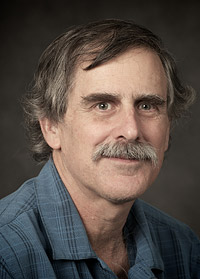
Interview with Scott Hannahs
SKEPTICALITY EPISODE 172
This week’s guest on Skepticality is Dr. Scott Hannahs, the Director of DC Field Instrumentation and Facilities National High Magnetic Field Laboratory. Find out a bit about what it is like to work with the worlds most powerful magnet, what types of experiments require such a powerful bit of scientific equipment, and what discoveries and research come out of the science of magnetic fields.

About this week’s eSkeptic
In this week’s eSkeptic, Michael Shermer reviews Margaret Wertheim’s Physics on the Fringe: Smoke Rings, Circlons, and Alternative Theories of Everything. This book review first appeared in the Wall Street Journal on December 10, 2011.
On the Margins of Science
book review by Michael Shermer
As the editor of Skeptic magazine and a monthly columnist for Scientific American I am often sent self-published books and manuscripts that I store in a box labeled “Theories of Everything.” These are mostly attempts at constructing all-encompassing explanatory theories claiming to have disproven Newton, Einstein, and Hawking, and that in 10 or 100 pages sans equations or references the secrets of the cosmos are revealed. One is entitled “Introduction to the Unified Field Theory,” in which the author boasts, “I have discovered the previously unknown invisible particle that fully explains light and all forms of energy. I call it the froton particle. Einstein didn’t know about the froton particle—but you will.” A manuscript entitled Infinite Dynamics goes “beyond Einstein,” and represents “an historic, classical, artistic, scientific, philosophical paradigm shift.” Another called Photonics promises “Einstein’s unified-field theory now complete, all forces finally unified,” and as a bonus, “fundamental cause of gravity found.” Another proclaimed that his “is the first consistent theory of anti-gravity in the history of mankind,” revealing the secrets to “time warp interstellar travel, wormhole engineering and Dipole Antigravity Drive, gravitational free energy, and alien visitation.”
I admit that I have not given these ideas much credence, but what if one of them turns out to be right, or at least has something of value to offer to society? For the past 15 years the acclaimed science writer Margaret Wertheim (Pythagoras’ Trousers, The Pearly Gates of Cyberspace) has been collecting the works of such hermit scientists, or what she calls “outsider physicists,” and with the patience of Job has undertaken the scientifically thankless task of carefully reading as many “theories of everything” as she could get her hands on to give them a fair hearing, and more. In Physics on the Fringe Wertheim presents these ideas with an eye toward challenging our preconceptions of what science is, how it works, and who it is for. The book is so well-written, entertaining, and enlightening that I read it straight through in one sunny day at the beach. Only later did I realize that Wertheim has also taken on one of the knottiest conundrums in the philosophy of science called the demarcation problem, or finding criteria to define the boundary between science and pseudoscience. It’s not as easy as it sounds.
As a professional debunker I feel like I know bunk when I see it, and Wertheim has well captured the genre: “In all likelihood there will be an abundant use of CAPITAL LETTERS and exclamation points!!! Important sections will be underlined or bolded, or circled, for emphasis. Frequently the author will have seen fit to ease the professor’s path toward understanding by writing helpful comments in the margins of the paper or by highlighting critical passages with brightly colored felt-tip pens… The text itself will almost certainly herald its revolutionary nature in its opening paragraphs, claiming to reinvent if not the whole of physics…then at least substantial parts of it. At a minimum, the author will be proposing something radically new and often as not will have harsh words for the twin pillars of twentieth-century physics—relativity and quantum theory.”
Outward appearances aside, Wertheim has convinced me that I may be too hasty in dismissing outsiders a priori, most notably the central character of her story—a man she calls the Einstein of outsiders, Jim Carter, who has developed his own complete theory of matter, energy, and gravity that he demonstrates by experiments in his backyard with DIY contraptions involving garbage cans and a disco fog machine, from which he makes smoke rings to test his ideas about atoms, which he believes are constructed of “circlons,” or “Hollow, ring-shaped mechanical particles that are held together within the nucleus by their physical shapes,” as seen in Figure 1 (below), and in representing the helium atom in Figure 2, the 2nd simplest element made up of two circlons. His circlon theory allows him to tie together both quantum mechanics and the special and general theories of relativity, and his explanation for gravity is unorthodox to say the least: “if the earth’s surface is constantly moving away from its center, we must conclude that the earth, as well as all other matter, is constantly expanding in size; and it is this expansion that causes the phenomenon we know as gravity.”

Figure 1: The Circlon (courtesy of Jim Carter). See also Jim Carter’s Circlon Model of Nulcear Structure (PDF, copyright 1993).

Figure 2: The Helium Atom Circlon (courtesy of Jim Carter). See the Physics on the Fringe website for more information about Jim Carter’s physics, including links to photos and videos.
Before you laugh (especially at the neologism), as I initially did, Wertheim points out that string theory—touted regularly on science documentaries as the ultimate theory of everything endorsed by prominent scientists the world over—has not a shred of empirical evidence in its favor and is, in reality, nothing more than a mathematically elegant construct. If Carter’s circlon theory is pseudoscience, why isn’t string theory? For example, Wertheim describes a meeting she attended of the Natural Philosophy Alliance, a group devoted to challenging mainstream physics. The eccentric event played host to no fewer than 121 fringe theories of the universe, “each claiming to present a key to Ultimate Reality,” Wertheim recalled. It reminded her of the book The Three Christs of Ypsilanti, the story of three schizophrenic patients in a room together at the Ypsilanti State Hospital in Michigan, all of whom thought they were Jesus (each of whom ultimatey decided that the other two were imposters). At this conference, she recounted, “Everybody had the Answer. Everybody was the One.” There was bewilderment amongst the participants: “How exactly is a person supposed to respond to someone else’s harebrained theory when each person has his or her own Solution?”
Wertheim goes on to contrast the NPA gathering with a meeting of string theorists she attended in which such scientific supernovae as Stephen Hawking, Lisa Randall and Brian Greene spoke seriously about 11-dimensional universes, multiverses, parallel universes, and even the possibility of there being at least 10500 variants of string cosmologies, including one proffered by Stanford’s Leonard Susskind in which every universe that can exist does exist in a superuniversal space. When Wertheim asked the organizer of the insiders conference his opinion of one particularly dazzling talk, he enthused “Utterly splendid. Of course there’s not a shred of evidence for anything the fellow said.” As Wertheim recalled, “Whoever I talked with assured me that everybody else’s theories were unsupported by evidence and based entirely on arbitrary assumptions. None of this was driven by physical discoveries.”
What, then, are we to do with outsiders’ contributions to science? When they are contrasted with equally baseless theories, says Wertheim, listen to them. “In the final analysis Jim’s circlon-shaped particles may also be seen as manifestations of a string theory, for his subatomic springs are also coils of some minutely thin, ‘stuff.’ Jim came to the string concept more than thirty years ago, and the fact that this idea is now being embraced by the mainstream suggests to him that his other ideas will one day be vindicated too.”
Will they? Maybe. Or perhaps both circlon theory and string theory will go the way of phlogiston and phrenology on the scrapheap of science history. Time and observation will tell, for as the great astrophysicist who confirmed Einstein’s theory of relativity, Arthur Stanley Eddington, noted: “For the truth of the conclusions of science, observation is the supreme court of appeal.” In the meantime, let’s not dismiss outsiders before giving them their day in court. Margaret Wertheim has done just that in this splendid book.
May we suggest these related items…
-
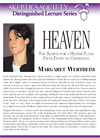 Heaven and the Internet
Heaven and the Internet
by Margaret Wertheim
-
 Who is Science Writing For?
Who is Science Writing For?
by Margaret Wertheim
-
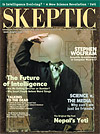 Skeptic magazine volume 10, no. 2
Skeptic magazine volume 10, no. 2
includes a special report on Stephen Wolfram by David Naiditch -
In 2002, the legendary Stephen Wolfram stepped into the public eye promising to revolutionize the way we do science. For hundreds of years, scientists have successfully used mathematical equations that show how various entities are related. Wolfram believes that simple computational rules (rather than equations) could better capture the complexities of nature. According to Wolfram, the discovery that simple rules can generate complexity—a discovery he attributes primarily to himself—is “one of the more important single discoveries in the whole history of theoretical science.”
READ the Table of Contents and order the back issue.
Physics on the Fringe: Smoke Rings, Circlons,
and Alternative Theories of Everything
and Alternative Theories of Everything
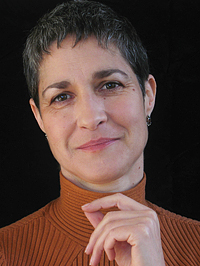
FOR THE PAST 15 YEARS acclaimed science writer Margaret Wertheim has been collecting the works of “outsider physicists,” many without formal training and all convinced they have found true alternative theories of the universe. Jim Carter, the Einstein of outsiders, has developed his own complete theory of matter and energy and gravity that he demonstrates by experiments in his backyard—with garbage cans and a disco fog machine, he makes smoke rings to test his ideas about atoms. Captivated by the imaginative power of his theories and his resolutely DIY attitude, Wertheim has been following Carter’s progress for the past decade. Through a profoundly human profile of Carter, Wertheim’s exploration of the bizarre world of fringe physics challenges our conception of what science is, how it works, and who it is for.
TAGS: fringe physics, Jim Carter11-12-07
In this week’s eSkeptic:
Lecture Sunday: Margaret Wertheim
Physics on the Fringe: Smoke Rings, Circlons,
and Alternative Theories of Everything
Sunday, December 11, 2011 at 2 pm
Baxter Lecture Hall
FOR THE PAST 15 YEARS acclaimed science writer Margaret Wertheim has been collecting the works of “outsider physicists,” many without formal training and all convinced they have found true alternative theories of the universe. Jim Carter, the Einstein of outsiders, has developed his own complete theory of matter and energy and gravity that he demonstrates by experiments in his backyard—with garbage cans and a disco fog machine, he makes smoke rings to test his ideas about atoms. Captivated by the imaginative power of his theories and his resolutely DIY attitude, Wertheim has been following Carter’s progress for the past decade. Through a profoundly human profile of Carter, Wertheim’s exploration of the bizarre world of fringe physics challenges our conception of what science is, how it works, and who it is for.
Tickets are first come, first served at the door. Seating is limited. $8 for Skeptics Society members and the JPL/Caltech community, $10 for nonmembers. Your admission fee is a donation that pays for our lecture expenses.

NEW ON MICHAELSHERMER.COM
Sacred Salubriousness
In the December Skeptic column for Scientific American, Michael Shermer looks at new research on the link between religion, behaviour, goal achievement and self-control.
NEW ON SKEPTICBLOG.ORG
Paleolithic Politics
Research in cognitive psychology shows, for example, that once we commit to a belief we employ the confirmation bias, in which we look for and find confirming evidence in support of it and ignore or rationalize away any disconfirming evidence. In this Skepticblog, in light of the group-psychology of our ancestral past, Michael Shermer looks at how the confirmation bias affects our still-tribal political process.

Unbottling some Jinn
If you think Genies are funny like in Aladdin, or sexy like in I Dream of Jeannie get ready to have your assumptions challenged. In the Middle East, Jinn aren’t whimsical characters of fantasy. They are considered to be frightening, real entities that haunt desolate places and can perform terrible magic. In this episode of MonsterTalk we interview author Robert Lebling about his book Legends of the Fire Spirits: Jinn and Genies from Arabia to Zanzibar. If you miss this episode you’ll wish you hadn’t!
Get the Podcast App
for your Android phone.
(iPhone App coming soon)
About this week’s eSkeptic
In this week’s eSkeptic, we present Karen Stollznow’s “Bad Language” column from Skeptic magazine volume 16, number 4 (2011) in which she looks at some of the pseudoscientific claims about the healing powers of sounds. Though most sound healing claims are just a lot of hot air, could there be some legitimate applications of sound technology being used to heal?
Healing and Harming Sounds
by Karen Stollznow

Illustration by Nancy White
Pavarotti singing Nessun Dorma from Puccini’s Turandot can bring people to tears, but can the tenor’s voice heal too? Can sounds both cure and kill? Let’s investigate some claims about healing and harming sounds.
Many people seem to think there’s something magical about human speech; for example, the belief that uttering spells and prayers can bring about an effect in the external world. Some practitioners even claim to be able to cure disease using the human voice. As usual, there are many names for the claims: Bioacoustics, Sound Therapy, Sound Work and Sound Medicine. All of these methods purport to harness the alleged healing power of our own voices.
One proponent, Paul Newham, believes that good health requires not only a sensible diet and exercise, but also singing. His book The Singing Cure teaches “Voice Movement Therapy,” a series of exercises based on “vocal healing traditions” from indigenous cultures.1 Newham claims the voice is a powerful healing instrument that can be used to tame anger, grief, shame and other negative emotions.
One “certified therapist” in Voice Healing conducts sessions of singing to reduce stress, ease pain and create a “cellular level of healing”:
This powerful healing technique which dates back to ancient civilizations and new scientific researches, will enable you to use the power of your voice vibration to improve your health and life. This course is for everybody; the human voice is a very powerful tool. it was not only created to speaking or singing, but also to heal and help each one of us (having a beautiful voice is not relevant) to achieve a state of greater self awareness. Once we get to know our voices with the help of intensive training we will be able to cure ourselves from many disturbing diseases and multiple pains caused by stress, such as insomnia, migraine, abdominal pain, heart problems, sinusitis, cold flu, and more…2
The Discovery Channel television series Mythbusters proved that with the right frequency and volume, and when sustained, it is possible to shatter glass with the human voice.3 However, no note is going to cure the common cold. Like mantras and meditation, singing only has subjective benefits for the individual.
Another therapist uses the voice in conjunction with music, drums, quartz crystal bowls and tuning forks, to return our voices to their “healthy state of resonance”:
We arrive on this planet with every thing that we need to heal ourselves, and when we came; our voices were rich with all the necessary frequencies to maintain us in a healthy state of resonance. Due to the conditioning of childhood and the suppression of our true thoughts and feelings and the accompanying sounds that go with them, by the time we arrive at adulthood our speaking voice no longer contains the same frequencies it did as a child. Our voice will always reflect our current mental and emotional states of being. When a person feels alive, healthy, happy and abundant, their voice sounds much different than if they are depressed, unhappy, angry or afraid. You may notice a difference in your own voice when speaking your truth compared to when you are not, it feels different in your body as well, and from an energetic standpoint the cells of your body are not getting the frequencies they need to stay healthy.4
Consistent with the beliefs of other holistic therapies such as naturopathy, this therapist claims that we all have a natural healthy state to which we can return using the body’s innate ability to heal itself.
To return to this inherent state of health, Alfred A. Tomatis experimented with the most seminal of sounds—a mother’s voice. To his patients, Tomatis played recordings of their mother’s voices to treat a variety of disorders, including dyslexia, autism and depression. He also used Gregorian chants and music by composer Wolfgang Amadeus Mozart. To this day, proponents of the Tomatis Method claim his listening techniques treat learning difficulties, and assist in learning second languages, developing better communication skills and improving creativity.5
By now, the idea of using Mozart music might be sounding familiar. Don Campbell took Tomatis’ research further with his book The Mozart Effect: Tapping the Power of Music to Heal the Body, Strengthen the Mind, and Unlock the Creative Spirit. Campbell believes that listening to Mozart music boosts intelligence, and in The Mozart Effect for Children he claims that exposing children to classical music increases brain development.
Campbell’s theory was popularized before it could be (dis)proven. The mere claim led then Governor of Georgia, Zell Miller, to propose issuing the parents of newborn children with a CD of classical music.6 In an effort to produce more milk, a dairy farmer in Spain plays Mozart during milking time, in what is affectionately known as the Moozart Effect.7
However, research does not support the claim that listening to Mozart can enhance spatial performance.8 Furthermore, there is no evidence to support Campbell’s additional claims that his therapy treats a range of conditions including autism, dyslexia and Attention- Deficit Hyperactivity Disorder (ADHD).9 Much like the “we only use 10% of our brains” myth, the belief that “listening to Mozart makes you smarter” has outlived its debunking.
Again, any benefits of listening to classical music are based in perception, like taste in music. One person’s Mozart is another person’s Metallica. Similarly, there is no music that will literally “expand your mind” like the claims of Squareeater that their psychedelic music “stimulates the brain to lead users to the furtherest edges of the conscious mind.”10
Music isn’t always used to soothe the savage beast; sometimes it’s used as a torture tactic. There was a curious soundtrack to the 1993 Waco siege of David Koresh and his disciples. When negotiations failed, the Federal Bureau of Investigation surrounded the Branch Davidian ranch and blasted high-decibel music into the compound to subdue the occupants. The bizarre playlist included Tibetan chants, Christmas carols, bugle calls and Nancy Sinatra’s These Boots Are Made for Walkin’. Like Charles Manson, Koresh fancied himself a rock star, and retaliated by playing tapes of his own compositions, until the electricity was cut off….
U.S. soldiers unleashed this rock ‘n’ roll warfare during the 1989 invasion of Panama. A cacophony of Styx, Judas Priest, Black Sabbath, and a version of God Bless the U.S.A. was blasted into the papal nunciature—Manuel Noriega’s hiding place—until the Vatican put an end to the concert. Closer to home, classical music is pumped into the PA systems of some shopping malls in an attempt to lower crime and deter teenagers from loitering (because Beethoven isn’t cool).
Sometimes earplugs aren’t enough. Sonic weapons are coming out of science fiction and into use for defense and law enforcement. Instruments such as Long Range Acoustic Devices (LRAD) are used as hailing devices and in crowd control efforts. An LRAD was even used to ward off a group of pirates off the coast of Somalia. High-power sound waves can be used to incapacitate a victim, and can cause disorientation, discomfort and nausea.
The very technology used to harm may be used to heal. Researchers at the California Institute of Technology have created “sound bullets” that could eventually be used to obliterate kidney stones or destroy cancerous cells without damage to surrounding tissue.11 The device is based on the old toy Newton’s Cradle, and creates concentrated sound waves from ball bearings.
In experimental research, sound waves are being used to treat prostate cancer. In a study conducted at the University College Hospital and Princess Grace Hospital in London, High Intensity Focused Ultrasound (HIFU) is used to kill cancerous cells. The results are promising; the cancer was treated successfully, with fewer side effects than chemotherapy.12
As we can see, there are some legitimate applications for sound technology, but there are many pseudoscientific theories about speech and sound. The claims that singing can cure disease and listening to music can make you smarter are just a load of hot air.![]()
References
- Paul Newham. 1993. The Singing Cure: Introduction to Voice Movement Therapy. Rider & Co.
- Manifesting Mind Power. Voice Healing. www.manifestingmindpower.com/voice%20healing.htm Accessed 04/20/2011.
- Karen Schrock. 2007. “Fact or Fiction? An Opera Singer’s Piercing Voice Can Shatter Glass.” Scientific American.
- The Healing Voice. www.soundtransformations.com/sacredvoice.htm Accessed 05/12/2011.
- Tomatis Method. www.tomatis.com Accessed 05/11/2011.
- Kevin Sack. 1998. “Georgia’s Governor Seeks Musical Start for Babies.” The New York Times. www.nytimes.com/1998/01/15/us/georgia-s-governor-seeks-musical-start-for-babies.html Accessed 05/11/2011.
- Rebecca Lee. 2007. The Moozart Effect. abcnews.go.com/Technology/story?id=3213324&page=1#.Tt6l5WCt_8g Accessed 05/11/2011.
- Pippa McKelvie, Jason Low. 2010. “Listening to Mozart does not improve children’s spatial ability: Final curtains for the Mozart effect.” Developmental Psychology. Vol. 20, No. 2, 241–258.
- Campbell, Don. 1997. The Mozart Effect: Tapping the Power of Music to Heal the Body, Strengthen the Mind, and Unlock the Creative Spirit. Quill Publishing.
- Squareeater. www.squareeater.com/ Accessed 05/17/2011.
- “Sound bullets” could blast cancer. ABC Science. April 2010. www.abc.net.au/science/articles/2010/04/06/2865165.htm Accessed 04/20/2011.
- Ahmed et al. 2009. “High-Intensity-Focused Ultrasound in the Treatment of Primary Prostate Cancer: The First UK series.” 1 July. British Journal of Cancer.
Suggested reading on sound perception, faith healing, and prayer…
-
 Phantom Words & Auditory Illusions
Phantom Words & Auditory Illusions
by Dr. Diana Deutsch
-
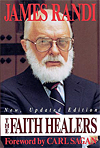 The Faith Healers
The Faith Healers
by James Randi
-
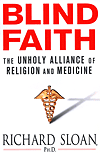 Blind Faith: The Unholy Alliance
Blind Faith: The Unholy Alliance
of Religion & Medicine
by Richard Sloan -
Is there a scientific connection between prayer and healing? A majority of Americans believe there is, but by taking a hard look at the scientific evidence, Columbia University Professor of Behavioral Medicine, Richard Sloan, believes there is no proven curative power to prayer and that the use of it as a medical treatment undermines effective patient care. Sloan exposes the questionable research practices and unfounded claims made by scientists who manipulate scientific data and research results to support their claim of effective mystical intervention in healing. READ more and order the hardback book.
11-11-30
In this week’s eSkeptic:
The Latest Episode of Mr. Deity: Mr. Deity and the Bang
WATCH THIS EPISODE | DONATE | NEWSLETTER | FACEBOOK | MrDeity.com
Upcoming Lecture: Margaret Wertheim
Physics on the Fringe: Smoke Rings, Circlons,
and Alternative Theories of Everything
Sunday, December 11, 2011 at 2 pm
Baxter Lecture Hall
FOR THE PAST 15 YEARS acclaimed science writer Margaret Wertheim has been collecting the works of “outsider physicists,” many without formal training and all convinced they have found true alternative theories of the universe. Jim Carter, the Einstein of outsiders, has developed his own complete theory of matter and energy and gravity that he demonstrates by experiments in his backyard—with garbage cans and a disco fog machine, he makes smoke rings to test his ideas about atoms. Captivated by the imaginative power of his theories and his resolutely DIY attitude, Wertheim has been following Carter’s progress for the past decade. Through a profoundly human profile of Carter, Wertheim’s exploration of the bizarre world of fringe physics challenges our conception of what science is, how it works, and who it is for.
Tickets are first come, first served at the door. Seating is limited. $8 for Skeptics Society members and the JPL/Caltech community, $10 for nonmembers. Your admission fee is a donation that pays for our lecture expenses.

NEW ON SKEPTICBLOG.ORG
Is America a Christian Nation?
Readers Respond To Chuck Colson
In a recent Los Angeles Times Op-Ed about Congress reaffirming the US national motto “In God We Trust,” Michael Shermer argued that trust does not come from God but from very specific social, political, and economic institutions. Chuck Colson argued that “God Has a Lot to Do With It.” In this week’s Skepticblog, readers respond to Colson.

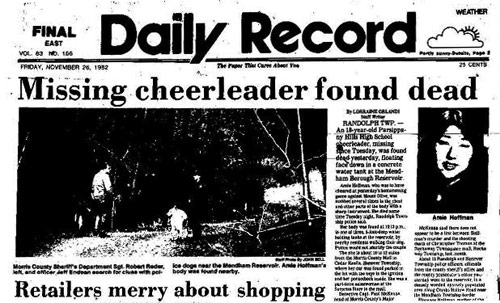
MonsterTalk meets Skeptiko: The Psychic Detective Finale
SKEPTICALITY EPISODE 170
In September of 2008, Ben Radford appeared as a guest on the podcast Skeptiko, hosted by Alex Tsakiris. During that interview, he agreed to take up Alex’s challenge to investigate the best case of the efficacy of psychic detectives. What followed was months of research, numerous interviews and a follow-up which ended in acrimony. Now, three years after the initial challenge, Skepticality presents a discussion between the hosts of MonsterTalk (Blake Smith, Ben Radford and Karen Stollznow) and Alex Tsakiris about Skeptiko, the interface of skeptics and believers, and the matter of whether or not Ben’s investigation disproved the psychic’s claims.
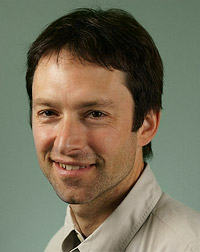
Interview with Joseph Lazio
SKEPTICALITY EPISODE 171
In this episode of Skepticality, Derek speaks with Joseph Lazio, project scientist at NASA’s Jet Propulsion Laboratory for the Square Kilometre Array (SKA) telescope. Learn about what this next-generation radio telescope will be searching for and discover how it will address some of the fundamental questions in astrophysics, physics, and even astrobiology.

About this week’s eSkeptic
In this week’s eSkeptic, Michael Shermer reviews Lisa Randall’s Knocking on Heaven’s Door: How Physics and Scientific Thinking Illuminate the Universe and the Modern World (Ecco, 2011), a book in which Randall attempts “the herculean task of explaining to us uninitiated the daunting science of theoretical particle physics.” This review was originally published in the November 2011 issue of Science magazine.
As Far As Her Eyes Can See
book review by Michael Shermer
Lisa Randall has been justly appraised by Time magazine as one of the “100 most influential people in the world” for her work in theoretical particle physics. From her position at Harvard University, she often travels: to the European Laboratory for Particle Physics, CERN, in Switzerland, where her theories are being put to the test in the Large Hadron Collider (LHC); to speaking engagements with professional and public audiences about her work in particular and the awe and wonder of science in general; and to rock formations where her chalked fingers can find ways to defy gravity. On the side, she writes popular books, such as her acclaimed Warped Passages1.
In Knocking on Heaven’s Door, Randall picks up the story from where she left off when the LHC was years away from first collision, expanding her horizon from, as she poetically puts it, “what’s so small to you is so large to me” to “what’s so large to you is so small to me.” In other words, the book ranges from the smallest known particles to the entire bubble universe, from 10−35 meters (the Planck length, where quantum gravity rules) to 1027 meters (the entire visible universe, 100 billion light-years across, where dark matter and dark energy dominate), a stunning 62 orders of magnitude. (Randall correctly notes the age of the universe at 13.75 billion years, clarifying her apparently paradoxical figure of 100 billion light-years thusly: “The reason the universe as a whole is bigger than the distance a signal could have traveled given its age is that space itself has expanded.” She unpacks that sentence in the book.)
At the time of this writing, eBooks occupy about 20 percent of sales space; that is, one out of every five books sold has no cover or binding save the faux effects offered digitally by the various eBook readers. Of late, however, a tiny and growing sliver of the pie is being carved out by audio books (primarily through Audible.com and iTunes), most unabridged and read by professional actors and readers. These provide a welcome alternative to those of us yoked to our iPods and MP3 players inside cars and gyms or on bicycles and hiking trails. Since fumbling around with cassette tapes and Sony Walkmans in the early 1980s, I have consumed on the order of 500- plus nonfiction audio books, so a measure of an author’s skill to communicate complex material clear enough to penetrate a multitasking cortex has become a mark of quality (or lack thereof). Many are called. Few are chosen. Randall’s explanatory prose places her among the elect. She is not alone, but she is rare among the many who have attempted the herculean task of explaining to us uninitiated the daunting science of theoretical particle physics. She devotes most of Knocking on Heaven’s Door to covering this science, along the way offering fascinating accounts of how the LHC was built, how the experiments are run, and, most notably, the engineering prestidigitation involved in teasing out nature’s secrets via energies never before witnessed on Earth.
The book’s subtitle hints that it may be yet another long and tiresome treatise on science and religion, with either convoluted (and ultimately failed) attempts at conciliation or pugnacious left hooks and fast jabs at the faithful. Neither are Randall’s modus operandi. She states her case succinctly and moves on. Stephen Jay Gould’s “nonoverlapping magisteria,” for example, would work if only religions would stick to doing what they do best (providing aid and comfort to the poor and needy). However, conflicts arise the moment “religions attempt to address the external reality of the universe.” When they do, Randall notes, “[t]his leaves religious views open to falsification. When science encroaches on domains of knowledge that religion attempts to explain, disagreements are bound to arise.” As science expands its realm, the magisteria are becoming ever more overlapping. The deeper problem, however, is that if divine providence were on the offing, “it is inconceivable from a scientific perspective that God could continue to intervene without introducing some material trace of his actions.” In other words, if God did act in the world scientists would want to know how he did it. “Did He apply a force or transfer energy?” Randall asks rhetorically. “Is God manipulating electrical processes in our brains? … On a larger level, if God gives purpose to the universe, how does He apply His will?” Inquiring minds want to know. Religion has no answer. I know because I have asked many times.
Another myth Randall thankfully busts is the notion of truth and beauty in science. What can a “beautiful truth” in science possibly mean? Take a look at a page of equations and formulas from a recent theoretical physics paper. Mind-boggling to the untrained maybe, complicated and detailed undoubtedly, surprising or inspiring occasionally, but beautiful? “Beauty is often agreed on only a posteriori,” Randall explains, although she adds the proviso “even though aesthetic criteria for science might be poorly defined, they are nonetheless useful and omnipresent. They help guide our research, even if they provide no guarantee of success or truth.” Considering weak interactions, which violate parity symmetry, she remarks, “The breaking of such a fundamental symmetry as left-right equivalence seems innately disturbing and unattractive. Yet this very asymmetry is what is responsible for the range of masses we see in the world, which is in turn necessary for structure and life.”
Knocking on Heaven’s Door came out before the faster-than-light neutrino experiment was announced2 and paraded through the press as an ostensible refutation of Einstein, implying in some circles that science is nothing more than one failed theory after another. Why thence should we believe anything scientists say about evolution, global warming, or vaccines? Randall ends her book with a thoughtful discussion of how science really works to resolve anomalies unexplained by the prevailing paradigm. Einstein did not overturn Newton; he just expanded on the physical properties of the universe at high speed and large scale. If you want to get a spacecraft to the moon, Newton will take you there. As flawed as it sometimes can be, science is still the most reliable tool ever devised for understanding the world. Few have captured this essence better than Randall in Knocking on Heaven’s Door.
References & Notes
- L. Randall, Warped Passages: Unraveling the Universe’s Hidden Dimensions (Allen Lane, London, 2005); reviewed in (3).
- http://arxiv.org/abs/1109.4897.
- J. D. Wells, Science 311, 40 (2006).
Suggested reading on cosmology and physics…
-
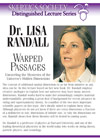 Warped Passages: Unraveling the Mysteries
Warped Passages: Unraveling the Mysteries
of Hidden Dimensions
by Dr. Lisa Randall
-
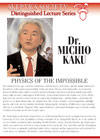 Physics of the Impossible
Physics of the Impossible
by Dr. Michio Kaku
11-11-23
25% off everything in our store, including subscriptions! SALE ON NOW THRU SUNDAY.
In conjunction with Black Friday (Nov. 25, in the US), we are offering our best sale of the year from now through Sunday. For 5 days only, everyone will save 25% off everything in the store including: books, DVDs, CDs, subscriptions, apparel, swag, as well as back issues of Skeptic magazine.
Giving gifts on December 25, Sir Isaac Newton’s birthday, has long been a tradition amongst skeptics. So, we’ve hand-selected the following gems from our catalogue that we think your friends and family will enjoy receiving. (Pssst! Remember: it’s okay to give yourself a gift too!)
All orders placed between Wednesday, Nov. 23 and Sunday, Nov. 27 will be discounted by 25% at checkout. Sale prices shown below include the 25% discount mentioned in the ad above. Sale ends at midnight Pacific Standard Time, Nov. 27, 2011.
For Christmas delivery, order by:
- December 9 for shipments outside the US
- December 19 for shipments inside the US
See our Holiday Shipping page for complete details.
Here’s What We Recommend

Skeptic Magazine Subscriptions
starting at $30.00
A subscription to Skeptic magazine, the definitive skeptical journal, makes a perfect gift that lasts all year. Promoting science and critical thinking, our articles explore and inform, and keep science at the forefront of public discourse.
ORDER a subscription
ORDER a gift subscription

The Baloney Detection Kit
by Michael Shermer & Pat Linse $5.00
This 16-page booklet, designed to hone your critical thinking skills, includes suggestions on what questions to ask, what traps to avoid, specific examples of how the scientific method is used to test pseudoscience and paranormal claims, and a how-to guide for developing a class in critical thinking.
ORDER the booklet
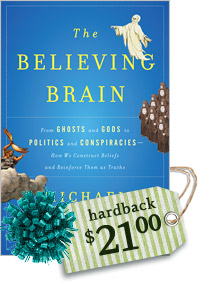
The Believing Brain
by Michael Shermer $28.00
In this, his magnum opus, Dr. Michael Shermer presents his comprehensive theory on how beliefs are born, formed, nourished, reinforced, challenged, changed, and extinguished. Sam Harris calls The Believing Brain “a wonderfully lucid, accessible, and wide-ranging account of the boundary between justified and unjustified belief.” Leonard Mlodinow calls it “a tour de force integrating neuroscience and the social sciences.”
ORDER the hardcover
LISTEN to the Prologue for free

How to Debate a Creationist
by Michael Shermer $5.00
This 28-page booklet is perfect for anyone who wants to know how to converse with a creationist. It contains 25 creationist arguments and 25 evolutionist answers (some philosophic and some scientific); describes what the theory of evolution is and isn’t and explains why creationism is not science; provides an in-depth understanding of Intelligent Design, its pitfalls and logical fallacies.; and much more…
ORDER the booklet

Trick or Treatment
by Simon Singh & Edzard Ernst, M.D. $25.95
This book is an excellent guide to the confusions and contradictions of alternative medicine written with clarity, integrity and authority. What works? Who can you trust? What alternative cures have positive results? What medical authorities are included in their “Top ten culprits in the promotion of unproven and disproven medicine?” Includes extensive information on the big four: acupuncture, homeopathy, herbs, and chiropractic, plus a “Rapid guide to Alternative Therapies.”
ORDER the hardcover

Natural Experiments
of History
edited by Jared Diamond
& James Robinson $29.95
“A superb collection of eminently teachable essays bound together by a common methodological framework that connects it directly to cutting-edge theoretical and empirical research across the disciplines of anthropology, archeology, history, political science, and sociology.” —John Coatsworth, Columbia University. Jon Christensen of Nature says, “All of the essays in Natural Experiments of History will trigger debate.”
ORDER the hardcover
for Young Readers,
by Daniel Loxton

Evolution: How We and All Living Things Came to Be
by Daniel Loxton $18.95
Hailed as a “tour-de-force of science writing,” the multi-award-nominated Evolution has been crowned with Canada’s largest literary prize for children’s science books. Combining lavish illustrations, breezy prose, and deep science, this primer for ages 8–13 has been applauded by expert reviewers including the National Science Teachers Association, the American Association for the Advancement of Science, and the National Center for Science Education. Called “the best overview of evolution for children of which I’m aware,” by WIRED GeekDad, Evolution passes the all-important kid test: “This review is a couple of weeks later than I’d hoped, because my 6-yr-old kept stealing it and carrying it around the house to study.”
ORDER the hardcover

Ankylosaur Attack
by Daniel Loxton $16.95
Greeted by the Globe and Mail as “a mind-blower/eyeball popper for that dino-crazy species that lives among us,” Ankylosaur Attack is a suspenseful and spectacular storybook for ages 4 and up. Featuring photorealistic computer-generated dinosaurs, this new release tells an exciting fictional story that transports young readers to a prehistoric world as it might have really looked. “Even by current high standards, the full-spread art is uncommonly photorealistic,” raves Kirkus Reviews. Kids will cheer for the triumph of the armored plant-eaters at the heart of this naturalistic, yet emotionally moving story—and marvel at the immersive realism it achieves.
ORDER the hardcover
Critical Thinking Classics
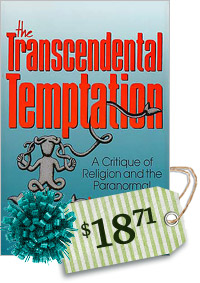
Transcendental Temptation
by Paul Kurtz $24.95
In this magnum opus, philosopher Paul Kurtz provides a critique of religion and the paranormal, brilliantly comparing ancient religions with modern New Age beliefs, showing the magical thinking that goes into the temptation we all experience to transcend the here and now for otherworldly spirituality.
ORDER the paperback

The New Age: Notes of a Fringe Watcher
by Martin Gardner $26.00
This book is a classic of skeptical literature filled with thirty-three diverse chapters: a bountiful offering of the delightful drollery and horse sense that has made Martin Gardner the undisputed dean of the critics of pseudoscience. It is also a quick way to get up to speed on many topics.
ORDER the paperback
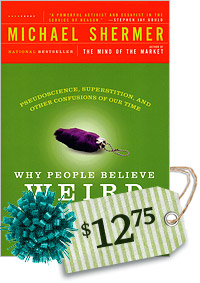
Why People Believe
Weird Things
by Michael Shermer $17.00
In this age of supposed scientific enlightenment, many people still believe in mind reading, past-life regression theory, New Age hokum, and alien abduction. A no-holds-barred assault on popular superstitions and prejudices, this book debunks these nonsensical claims and explores the very human reasons people find otherworldly phenomena, conspiracy theories, and cults so appealing.
ORDER the paperback

Doubt: A History
by Jennifer Michael Hecht $16.95
This stimulating book is a grand history that celebrates the great doubters and their legacies as
agents of creativity and change. Detroit Free Press says, “Hecht gleefully invites readers on a lively stroll through three millennia of clashes between believers and nonbelievers.” Publisher’s Weekly says, “Hecht’s poetical prose beautifully dramatizes the struggle between belief and denial…”
ORDER the paperback
Fun with Math & Physics

Secrets of Mental Math
by Arthur Benjamin
& Michael Shermer $12.95
The Mathemagician’s Guide to Lightning Calculation and Amazing Math Tricks will have you thinking like a math genius in no time! Get ready to amaze your friends—and yourself—with incredible calculations you never thought you could master, as renowned “mathemagician” Arthur Benjamin shares his techniques for lightning-quick calculations and amazing number tricks. This book will teach you to do math in your head faster than you ever thought possible, dramatically improve your memory for numbers, and—dare we say, maybe for the first time—actually make mathematics fun!
ORDER the paperback

The Physics of
the Buffyverse
by Jennifer Ouellette $15.00
The Buffyverse is an undeniably bizarre place—a world where the melding of magic and science is a defining feature, and mystical convergences and otherworldly phenomena are everyday occurrences. In the tradition of Krauss’s The Physics of Star Trek, Jennifer Ouellette explains complicated principles of biology, chemistry, and theoretical physics. From electricity, conservation of energy, and special relativity to wormholes, black holes, and string theory, The Physics of the Buffyverse provides a serious shot of science for those who prefer their physics with a pop-culture chaser.
ORDER the paperback
by Richard Dawkins
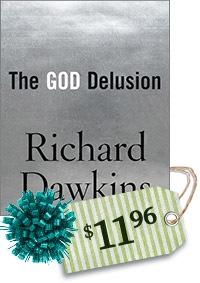
The God Delusion
by Richard Dawkins $15.95
One of Dawkins’ most important books, this one is his definitive statement on the God question, the origins of morality and religion, the best arguments for and against God’s existence, the dangers of religious extremism, and why science offers the best hope for humanity. Scientific American says,
“Dawkins is frequently dismissed
as a bully, but he is only putting theological doctrines to the same kind of scrutiny that any scientific theory must withstand.”
ORDER the paperback
ORDER the lecture on DVD
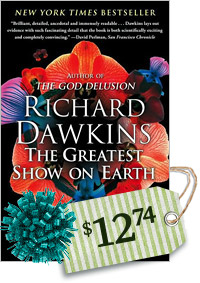
The Greatest Show on Earth
by Richard Dawkins $16.99
This New York Times bestseller is a fierce counterattack against proponents of “Intelligent Design.” Educators are being asked to “teach the controversy” behind evolutionary theory. There is no controversy. Dawkins sifts through rich layers of scientific evidence to make the airtight case that “we find ourselves perched on one tiny twig in the midst of a blossoming and flourishing tree of life and it is no accident, but the direct consequence of evolution by non-random selection.”
ORDER the paperback
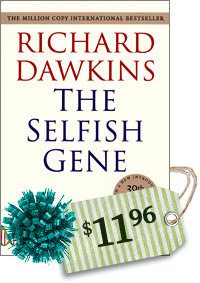
The Selfish Gene
by Richard Dawkins $15.95
Dawkins’ brilliant reformulation of the theory of natural selection has the rare distinction of having provoked as much excitement and interest outside the scientific community as within it. This
30th anniversary edition retains all original material and a new Introduction wherein the author presents his thoughts thirty years after the publication of his first and most famous book, while the inclusion of the two-page original Foreword by brilliant American scientist Robert Trivers shows the enthusiastic reaction of the scientific community at that time.
ORDER the paperback
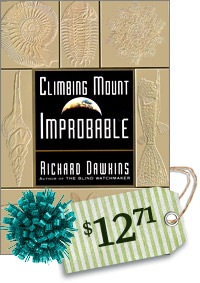
Climbing Mount Improbable
by Richard Dawkins $16.95
A brilliant book celebrating improbability as the engine that drives life. The human eye is so complex and works so precisely that it appears to be the product of design. How could such an intricate object have come about by chance? Dawkins builds a carefully reasoned and lovingly illustrated argument for evolutionary adaptation as the mechanism for life on earth. The eye did not come about by chance. It was designed … by evolution.
ORDER the paperback
by James Randi
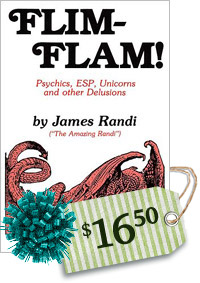
Flim-Flam!
by James Randi $22.00
Flim-Flam, a classic masterpiece—and the bible of the skeptical movement—is Randi’s account of dozens of his personal investigations into the paranormal that no skeptical bookshelf should be without. With an Introduction by Isaac Asimov, this book includes Randi’s investigations of the Bermuda Triangle, alternative medicine, Transcendental Meditation, ESP, PSI, and how Sir Arthur Conan Doyle got taken by fake fairy photographs (despite Houdini’s debunking of them).
ORDER the paperback
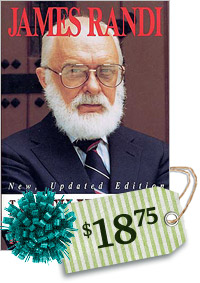
The Faith Healers
by James Randi $25.00
This book is Randi’s greatest investigation and exposé of Peter Popoff, W.V. Grant, Pat Robertson, and Oral Roberts, as seen on the Tonight Show. Steve Martin’s Leap of Faith was based on this book and Randi won a MacArthur “Genius Award” for this work. The Toronto Sun calls it, “A fascinating loo at a world of misplaced faith and blind trust that seems more appropriate to the Dark Ages than to the end of the 20th century.”
ORDER the paperback
by Donald Prothero

Greenhouse of
the Dinosaurs
by Donald Prothero $29.95
Prothero discusses the latest findings in geology and paleontology, providing an insider’s view of the profession. His detailed, first-person narrative allows readers to experience the personalities, the debates, the controversies, the development of new scientific techniques, and the latest scientific findings as they happened. This book is a valuable, no-nonsense, must-read for anyone interested in paleontology or geology, or anyone considering entering those fields.
ORDER the hardcover

Catastrophes!
by Donald Prothero $30.00
Catastrophes! Earthquakes, Tsunamis, Tornadoes, and Other Earth-Shattering Disasters is a fascinating read, describing historic catastrophic events and the forces that cause them in gripping detail. These tales of geologic history and human fortitude and folly will stay with you long after you put the book down, leaving you with a respect for the mighty power of the earth—and a humbling view of our future.
ORDER the hardcover
by Sam Harris
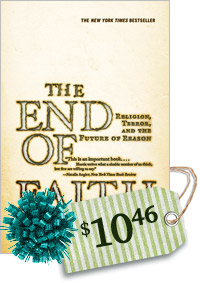
The End of Faith
by Sam Harris $13.95
Sam Harris’ first book was an instant bestseller because of its cogent arguments and literary clarity, in which the author argues that because of weapons of mass destruction the world can no longer tolerate violent religions, and that in fact even moderate religious beliefs only encourage extremists by enabling their supernatural beliefs.
ORDER the paperback
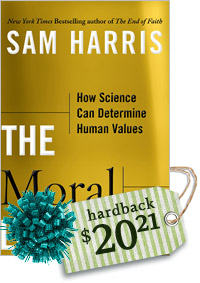
The Moral Landscape
by Sam Harris $26.95
Sam Harris tears down the wall between scientific facts and human values, arguing that most people are simply mistaken about the relationship between morality and the rest of human knowledge, and urges us to think about morality in terms of human and animal well-being, viewing the experiences of conscious creatures as peaks and valleys on a “moral landscape.”
ORDER the hardcover
on the Bible

Secret Origins of the Bible
by Tim Callahan $29.95
Callahan uses ancient history, linguistics, archaeology, comparative mythology, and numismatics to reveal that all major stories in the Bible have historical antecedents that can be traced to very non-divinely produced works by other cultures. A must-read for anyone wishing to understand the Bible.
ORDER the hardcover
ORDER the lecture on DVD

The Bible Against Itself
by Randel Helms $21.95
With depth and clarity Dr. Helms shows that, throughout the history of their formation, the Jewish and Christian scriptures developed as the by-products of ongoing theological debates. Far from expressing the unity of thought and doctrinal accord that would reflect divine inspiration, the scriptures represent a series of furious and unrelenting disputes between authors supporting often bitterly divided dogmas.
ORDER the hardcover
ORDER the paperback
ORDER the lecture on DVD

Who’s in Charge? Free Will and the Science of the Brain
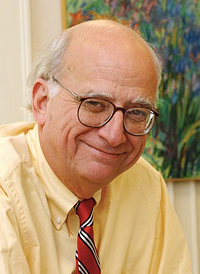
DO WE HAVE FREE WILL or are our lives simply determined by the same physical laws that control the world around us? For the most part, science has embraced the determinist point of view. But the U.C. Santa Barbara psychologist Michael S. Gazzaniga—the man Tom Wolfe has called “one of the most brilliant experimental neuroscientists in the world”—is not convinced. Gazzaniga argues that the human mind acts to constrain the brain and monitor our behavior, much as a government, created by a society, provides constraints on those who conceived it. Drawing on cutting-edge neuroscience and psychology, as well as ethics and law, he offers a deeply considered case for human responsibility: we are accountable for our actions.
TAGS: determinism, free will, Michael Gazzaniga11-11-16
Lecture Sunday: Michael Gazzaniga
Who’s in Charge? Free Will & the Science of the Brain
Sunday, November 20, 2011 at 2 pm Baxter Lecture Hall
DO WE HAVE FREE WILL or are our lives simply determined by the same physical laws that control the world around us? For the most part, science has embraced the determinist point of view. But the U.C. Santa Barbara psychologist Michael S. Gazzaniga—the man Tom Wolfe has called “one of the most brilliant experimental neuroscientists in the world”—is not convinced. Gazzaniga argues that the human mind acts to constrain the brain and monitor our behavior, much as a government, created by a society, provides constraints on those who conceived it. Drawing on cutting-edge neuroscience and psychology, as well as ethics and law, he offers a deeply considered case for human responsibility: we are accountable for our actions.
Tickets are first come, first served at the door. Seating is limited. $8 for Skeptics Society members and the JPL/Caltech community, $10 for nonmembers. Your admission fee is a donation that pays for our lecture expenses.

NEW ON SKEPTICBLOG.ORG What’s God Got To Do With It?
Michael Shermer chimes in on the House of Representatives voting last week by a margin of 396–9 to reaffirm as the national motto the phrase “In God We Trust.” God may be invoked in the national motto, but He has nothing to do with why Americans are free and secure…
About this week’s eSkeptic
In this week’s eSkeptic, Paul J. Cech reviews Michael Ruse’s Science and Spirituality: Making Room for Faith in the Age of Science (2010, Cambridge University Press).
Making Room for Religion
by Paul J. Cech
In Science and Spirituality, Michael Ruse offers believers (especially Christians) the possibility that their beliefs can coexist with science as they contemplate ideas “that go beyond the reach of science (233).” He simultaneously offers scientists and scholars an historic and liberal view of a world where science and human values help us to increase our understanding and strengthen our respect for those who see things differently. He also offers interested general readers a readable, rational account of the history and philosophy of evolution.
The first four chapters are a detailed historical account of scientific thought in Western civilizations. Ruse provides perspectives on organic and mechanical metaphors, as he methodically explains their details in a manner that will not only refresh or enhance the understanding of scientists and other learned scholars, but in a way that provides background information for students and general readers to refer to as they delve into the analysis that is the focus of subsequent chapters. In the Introduction, Ruse provides information on the players in the discussion about religion and science. Among them are: Steven Weinberg, Sir John Polkinghorne, Francis Crick, James Watson, Richard Dawkins, Daniel Dennett, Arthur Peacocke, and Stephen Jay Gould.
Chapter One, The World as an Organism, covers the Greek perspective, and the use of metaphor in science. Chapter Two, The World as a Machine, focuses on the development of science “from Copernicus to Newton.” It concludes with more details about the machine metaphor: “The world as a machine is not something discovered…It is something we create in conjunction with nature” (52). In Chapter Three, Organisms as Machines, the focus is on philosophy. The reader is offered greater details about the machine metaphor and various philosophical perspectives on organisms, mechanisms, and evolution. This is the point where I had to get my copy of Samir Okasha’s Philosophy of Science: A Very Short Introduction (Oxford University Press, 2002) down from the shelf and placed nearby for comfort. The ideas of several philosophers were presented, among them Kant and Descartes. There are also ideas from scientists and thinkers such as: Heinrich Gustav Magnus, Edward Franklin, Charles Darwin, T.H. Huxley, and Richard Dawkins. With Chapter Four, Thinking Machines, I returned to a more comfortable arena. Here one finds the ideas of William James, Noam Chomsky, Edward O. Wilson, Stephen Pinker, and Paul Thagard. I was even pleasantly surprised by references to Viktor Frankl and Rollo May (104). The ideas presented in the first four chapters cover questions and ideas related to the history of scientific thought and they prepare the reader for the analysis that follows. In Chapter Five, Unasked Questions, Unsolved Problems, includes discussion of origins, morality, minds, and purpose. The ideas of various thinkers are used to explore the question, “Why is there something rather than nothing?” The ideas related to morality had me returning to the my bookshelf to get an old, well-worn copy of Jacob Bronowski’s Science and Human Values (Harper Colophon Books, 1975), in which civilization asks science and Nagasaki, which is described as an “industrial slum”, the question: Is You Is Or Is You Ain’t My Baby? It dawned on me while reading this chapter that as civilized individuals, as scientists and scholars asking questions about origins, morality, minds and purpose, is there really room for faith in this scientific age? This thought remained with me as I made my way through the remaining chapters. Chapter Six, Organicism, addresses a call for the return to the organic metaphor from the machine metaphor. Ruse presents detailed information about Naturphilosphie and other developments, as well as emergence, Gaia and ecofeminism, and he provides a summary of organicism. In the final two chapters on God and Morality, Souls, Eternity, Mystery, Ruse presents the theological foundations of faith for Christians, especially as they relate to the idea of God. Ruse aims not to prove “the truth of Christianity but to make room for it in the face of science” (193). A key point here is the rejection of theological concepts or ideas rooted in faith if they cannot hold up to the light of modern science.
In his Conclusion, Ruse states that he hopes that the “ideas and conclusions” found in Science and Spirituality will “inspire” others to join him in making room for faith in an age of science. I think it will. How? Early in the book, Ruse quotes the New York Times science writer Natalie Angier saying that science “has made it possible for people not to be religious.” I like that. Religion in general—more specifically, belief in god—comes with mixed blessings. I wholeheartedly agree that theology needs to be aligned with the findings of modern science. Theology needs to adapt. Religious beliefs need to be revised. Social Sciences have also shown us that religion has a purpose in society; it helps to reinforce norms that I hope are in step with modern science, and religion helps to alleviate anxiety, something that may be necessary for pious folk who truly believe as they face numerous concerns on a daily basis. Ruse wrote Science and Spirituality to help believers, especially Christians, to see that their beliefs can co-exist with science. But he also makes it possible for scientists and scholars to see the possibility of science that coexists with the humanities. This unification may help us all to accept and understand each other a little better. It may also help us to be better prepared if civilization has a need to ask science, is you is or is you ain’t my baby? ![]()
About the Author
Paul J. Cech is a poet and educator. His interests include evolution, human behavior (socialization and cognition), and American culture and society. He is a member of The National Center for Science Education (NCSE), The History of Science Society, Society for Police and Criminal Psychology (SPCP), APA Div. 2, and the Pennsylvania Geographical Society (PGS). His formal education includes Associate Letters, Arts, and Sciences (writing) Pennsylvania State University—Fayette 1979; BA (Psychology) California University of Pennsylvania (CUP) 1981; Pennsylvania Teaching Certificate (Secondary Social Studies) CUP 1983; MA (Geography and Regional Planning) CUP 1987. He is a member of Pi Gamma Mu and Gamma Theta Epsilon. Cech’s book reviews have been published in The Pennsylvania Geographer, ISIS, and The Quarterly Review of Biology. His latest poems were published on The Other Voices International Project, Vol. 45.
Suggested reading on religion, science and spirituality…
-
 The Soul of Science by Michael Shermer
The Soul of Science by Michael Shermer
-
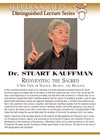 Reinventing the Sacred: A New View of Science, Reason & Religion by Dr. Stuart Kauffman
Reinventing the Sacred: A New View of Science, Reason & Religion by Dr. Stuart Kauffman
-
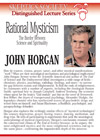 Rational Mysticism: The Border Between Science & Religion by John Horgan
Rational Mysticism: The Border Between Science & Religion by John Horgan
The Folly of Fools: The Logic of Deceit and Self-Deception in Human Life
Whether it’s in a cockpit at takeoff or the planning of an offensive war, a romantic relationship or a dispute at the office, there are many opportunities to lie and self-deceive—but deceit and self-deception carry the costs of being alienated from reality and can lead to disaster. So why does deception play such a prominent role in our everyday lives? In his bold new work, Rutgers University evolutionary theorist Robert Trivers unflinchingly argues that self-deception evolved in the service of deceit—the better to fool others. We do it for biological reasons—in order to help us survive and procreate. From viruses mimicking host behavior to humans misremembering (sometimes intentionally) the details of a quarrel, science has proven that the deceptive one can always outwit the masses. But we undertake this deception at our own peril.
This lecture was recorded on November 13, 2011 as part of the Distinguished Science Lecture Series hosted by Michael Shermer and presented by The Skeptics Society in California (1992–2015).
We offer this lecture to you freely, and greatly appreciate your support.
TAGS: logic of deceit, self-deception, why do we deceive11-11-09
In this week’s eSkeptic:
- November 9, 1934: Happy Birthday Carl Sagan!
- Lecture This Sunday: Logic of Deceit & Self-Deception (Robert Trivers)
- Follow Michael Shermer: Skepticism 101: 2nd Call for Course Syllabuses
- Podcast Double Header: Skepticality and Monstertalk
- Follow Daniel Loxton:Kitchen Table Cryptozoology
- Upcoming Geology Tours: Whale Watching (a few seats left!)

Happy Birthday Carl Sagan!
November 9, 1934 – December 20, 1996
If you wish to make an apple pie from scratch, you must first invent the universe.
FEW CELEBRITIES IN SCIENCE have done more for the promotion of science, reason, rationality, and critical thinking than Carl Sagan, whom we remember today upon the occasion of his birthday: November 9, 1934. Carl would have been 77 years old today. Happy Birthday Carl!
3rd Annual Carl Sagan Day
This Saturday, November 12, 2011, marks the third annual Carl Sagan Day, which takes place at Broward College: North Campus in Coconut Creek, Florida. This free event is a celebration of the life and teachings of Carl Sagan, whose many books, television appearances (most notably Cosmos), and NASA projects influenced a generation of thinkers. For more information, go to carlsaganday.com.
The Measure of a Man
In celebration of Carl Sagan Day, we would like to share with you a free lecture from our Distinguished Lecture Series at Caltech: Carl Sagan: The Measure of a Man. In this lecture, Michael Shermer, William Poundstone and Keay Davidson take an illuminating look back over the life and legacy of one of the 20th Century’s most celebrated astronomers.
Dr. SETI: “Cosmic Carl”
Back in 2009, Daniel Loxton put together a free, downloadable Skeptics Mix Tape, comprised of a selection of songs of science and skepticism. In one of the songs, Cosmic Carl, folk singer Dr. SETI leads a live audience in a fond shout-out to the late, great astronomer Dr. Carl Sagan. Have a listen and feel free to download ALL the songs in MP3 format for non-commercial use at home or in your classroom.
Carl Sagan Tribute Articles
Skeptic.com has a compendium of articles on Carl Sagan that you can read for free on on our website. Several of them are tribute articles from various back issues of Skeptic magazine.
Items of Interest at Shop Skeptic (limited availability)
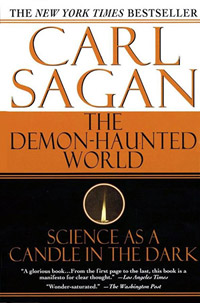
Demon-Haunted World
Order the book from Shop Skeptic
Order the book from Amazon
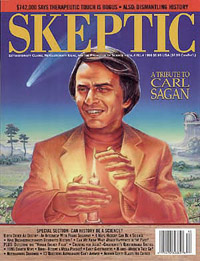
Skeptic magazine vol. 4, no. 4
Order this back issue
Subscribe to Skeptic magazine
Lecture Sunday: Robert Trivers
The Folly of Fools: The Logic of Deceit and
Self-Deception in Human Life
Sunday, November 13, 2011 at 2 pm
Baxter Lecture Hall
WHETHER IT’S IN A COCKPIT AT TAKEOFF OR THE PLANNING OF AN OFFENSIVE WAR, a romantic relationship or a dispute at the office, there are many opportunities to lie and self-deceive—but deceit and self-deception carry the costs of being alienated from reality and can lead to disaster. So why does deception play such a prominent role in our everyday lives? In his bold new work, Rutgers University evolutionary theorist Robert Trivers unflinchingly argues that self-deception evolved in the service of deceit—the better to fool others. We do it for biological reasons—in order to help us survive and procreate. From viruses mimicking host behavior to humans misremembering (sometimes intentionally) the details of a quarrel, science has proven that the deceptive one can always outwit the masses. But we undertake this deception at our own peril.
Tickets are first come, first served at the door. Seating is limited. $8 for Skeptics Society members and the JPL/Caltech community, $10 for nonmembers. Your admission fee is a donation that pays for our lecture expenses.

Skepticism 101: 2nd Call for Course Syllabuses
from Those Teaching Skeptical Courses
A few weeks ago, I sent out a call for all teachers and professors who are teaching courses in skepticism, critical thinking, science and pseudoscience, science and the paranormal, science studies, history or philosophy of science, the psychology of paranormal beliefs, religious studies, and the like…
Thank you very much to those of you who have already contributed. We appreciate your efforts and your support. For those of you would like to contribute, please EMAIL Anondah Saide
(one of my graduate students) with your:
- course syllabuses,
- lectures,
- Powerpoint presentations,
- reading lists,
- YouTube videos,
- classroom demonstration ideas,
- student projects and experiments,
- research project ideas, and the like.
I want to add them to my own Course Syllabus on Skepticism 101, and create an online Skeptical Studies Program at Skeptic.com for teachers and professors everywhere to go to in a creative commons/open source system so that we can build a new academic field going forward with skepticism into academia.
To start the process off I share with you my own Course Syllabus for Skepticism 101, which I am teaching this semester at Chapman University on Tuesdays from 4–7pm with 36 freshman, the future of the skeptical movement!

Skepticality
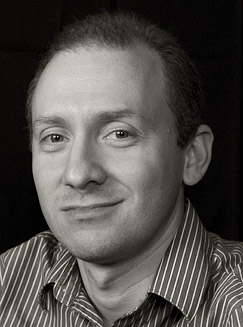
Interview with A.J. Mass
This week on Skepticality, Derek interviews A.J. Mass (a staff writer for ESPN, and card dealer in Atlantic City) to discuss his new book How Fantasy Sports Explains the World: What Pujols and Peyton Can Teach Us About Wookiees and Wall Street. From the Last Supper to Star Wars, winning advice about almost any facet of life can be found almost anywhere, especially when you pay attention to reality and the current known odds.
MonsterTalk
Paranormality: Psychic Dogs, Ghosts and Silly Voices—an Interview with Richard Wiseman
While at TAM9, the hosts of MonsterTalk sat down to talk with psychologist Richard Wiseman about his new book Paranormality: Why we see what isn’t there. It was supposed to be a chat about the paranormal, ghosts and Wiseman’s findings. But a conversation with Richard Wiseman is rarely so simple as that.

NEW ON SKEPTICBLOG.ORG
Kitchen Table Cryptozoology
As part of the research for his upcoming book on cryptozoology with Donald Prothero, Daniel spends a few minutes playing with playdough at the kitchen table—and demonstrates a simple but under-appreciated principle behind false positive sea serpent sightings.
Some spaces available on our
Upcoming Geology Tours
Whale Watching, Geology and Tide Pools
November 12, 2011
We have a few spots left on our 1-day whale watching tour coming up on November 12, 2011. Questions? Email us. To register, call 1-626-794-3119 with a credit card to secure your spot.
Viva Mojave!
January 14–16, 2012
We still have space available for this tour from January 14–16, 2012 which highlights the Mojave Desert and the Las Vegas area, Calico, Afton Gorge where Ice Age floods drained Lake Manix, Red Rock Canyon, and the Hoover Dam. Explore the Las Vegas Strip on your own in the evening.
Thinking: Fast and Slow
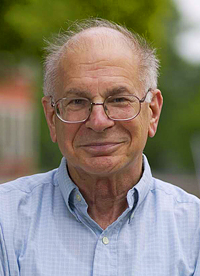
THE IDEAS OF THE PRINCETON UNIVERSITY PSYCHOLOGIST DANIEL KAHNEMAN, recipient of the Nobel Prize in Economic Sciences for his seminal work that challenged the rational model of judgment and decision making, have had a profound and widely regarded impact on psychology, economics, business, law and philosophy. Until now, however, he has never brought together his many years of research and thinking in one book. In the highly anticipated Thinking, Fast and Slow, Kahneman introduces the “machinery of the mind.” Two systems drive the way we think and make choices: System One is fast, intuitive, and emotional; System Two is slower, more deliberative, and more logical. Examining how both systems function within the mind, Kahneman exposes the extraordinary capabilities and also the faults and biases of fast thinking, and the pervasive influence of intuitive impressions on our thoughts and our choices. Kahneman shows where we can trust our intuitions and how we can tap into the benefits of slow thinking. He offers practical and enlightening insights into how choices are made in both our business and personal lives, and how we can guard against the mental glitches that often get us into trouble. Kahneman will change the way you think about thinking.
TAGS: brain, Daniel Kahneman, fast cognition, intuition, machinery of the mind, slow thinking, Thinking Fast and Slow11-11-02
In this week’s eSkeptic:
- Lecture This Sunday: Thinking: Fast & Slow (Daniel Kahneman)
- November Geology Tour: Whale Watching (only a few seats left!)
- Follow Michael Shermer: Social Singularity, Scientology, and Wall Street
- Feature article: Where the Substance Really Isn’t
- Upcoming Events: at the Geffen Playhouse: The Passion of Marie Curie
Lecture Sunday: Daniel Kahneman
Thinking: Fast and Slow
Sunday, November 6, 2011 at 2 pm
Baxter Lecture Hall
THE IDEAS OF THE PRINCETON UNIVERSITY PSYCHOLOGIST DANIEL KAHNEMAN, recipient of the Nobel Prize in Economic Sciences for his seminal work that challenged the rational model of judgment and decision making, have had a profound and widely regarded impact on psychology, economics, business, law and philosophy. Until now, however, he has never brought together his many years of research and thinking in one book. In the highly anticipated Thinking, Fast and Slow, Kahneman introduces the “machinery of the mind.” Two systems drive the way we think and make choices: System One is fast, intuitive, and emotional; System Two is slower, more deliberative, and more logical…
Tickets are first come, first served at the door. Seating is limited. $8 for Skeptics Society members and the JPL/Caltech community, $10 for nonmembers. Your admission fee is a donation that pays for our lecture expenses.
Whale Watching, Geology and Tide Pools
We have only a few spots left on our 1-day whale watching tour coming up on November 12, 2011. Highlights include: a morning whale watching cruise on a boat reserved just for us, a tour of the Cabrillo Marine Aquarium, a marine biology lecture with special emphasis on tide pools, a visit to nearby tide pools during one of the lowest tides of the year, and a visit to some of the geologic highlights of the Palos Verdes Peninsula (including Portuguese Bend Landslide).
Questions?
Email us. To register, call 1-626-794-3119 with a credit card to secure your spot.
Download complete details and registration form for Whale Watching
Coming Up in January 2012: Viva Mojave!
JOIN US FOR A WONDERFUL THREE-DAY TOUR of the highlights of the Mojave Desert and the Las Vegas area, including: a visit to the historic restored ghost town of Calico, Afton Gorge where Ice Age floods drained Lake Manix, collect 550 million year old trilobites, experience the spectacular boulders of Red Rock Canyon, and conclude with a guided tour of Hoover Dam. Each night we will stay at the Excalibur Hotel on the Las Vegas Strip, where you can explore Sin City on your own.

NEW ON MICHAELSHERMER.COM
Social Singularity: Why Things Are Getting Progressively Better
Michael Shermer discusses the problem of tribalism, which we inherited from our primate ancestors, and which we must overcome if we are to achieve a stable and just global society. This lecture was recorded on October 15, 2011 at the Singularity Summit in New York.
The Real Science behind Scientology
In this month’s Skeptic column in Scientific American, Michael Shermer takes a brief look at Scientology.
NEW ON SKEPTICBLOG.ORG
Occupy This!
Michael Shermer shares his experience at Occupy Wall Street on October 16, 2011.
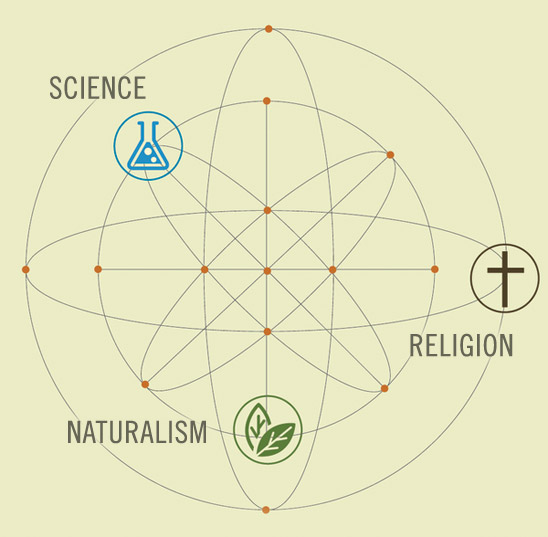
A review of Alvin Plantinga’s
Where the Conflict Really Lies
In this week’s eSkeptic, Tim Callahan reviews Alvin Plantinga’s Where the Conflict Really Lies: Science, Religion, and Naturalism (2011, Oxford University Press).
Where the Substance Really Isn’t
by Tim Callahan
Alvin Plantinga, O’Brien Professor of Philosophy at the University of Notre Dame, seems adept at talking philosophy around issues of science without ever grappling with anything concrete. Despite the length of this book I waded through its often impenetrably dense verbiage, searching in vain for much real substance. The author’s basic assertion is that, while there is superficial conflict between. science and religion (particularly Christianity), there is, in fact, a deep concord between the two. At the same time, he argues, there is a superficial concord between science and naturalism, but in reality, a deep conflict between them. Naturally, the supposed conflict between science and theism centers on evolution, and Plantinga takes atheist spokesmen—particularly the “four horsemen of the new atheism,” Richard Dawkins, Daniel Dennett, Sam Harris and Christopher Hitchens—to task for asserting that evolution is directionless and unguided:
In this chapter and the one previous, we have been looking into the claim that current scientific evolutionary theory is incompatible with Christian belief. This claim, as we saw, is false. The scientific theory of evolution is not incompatible with Christian belief; what is incompatible with it is the idea that evolution, natural selection, is unguided. But that idea isn’t part of evolutionary theory as such; it’s instead a metaphysical or theological addition. (p. 65)
While it’s true that the theory of evolution per se doesn’t preclude a creator deity, the fossil record, to which Plantinga never refers or alludes, would seem devoid of any teleological pattern.
Consider the basic thesis of a God with whom evolution is compatible. This is the God of teleological arguments, the God who creates life and spurs it on with mutations and natural selection, who goads it forward with the eventual goal of creating beings who, like Him (or Her), are sentient and self-aware. Across the vast panorama of deep time, the creator’s work stretches from the simplest life forms to the sentient apex of his grand design: namely, us. This is certainly the God I believed in when I was a theist, and, given the upward course of evolution, it did seem to me then to have a discernible pattern and a grand design.
The great curse on this picture, glaringly revealed in the fossil record, is the haphazard nature of mass extinctions. If humans were God’s goal, then the rise of mammals to dominance would have to be integral to that goal. By the end of the Permian Period, about 248 million years ago, the mammal-like reptiles were the dominant mega-fauna, and were poised to evolve into dominant mammals. Then the Permian-Triassic extinction wiped out up to 96% of all marine species and 70% of all terrestrial vertebrate species. Among those groups hard hit by this greatest of all mass extinctions were the synapsids, the mammal-like reptiles, which were almost entirely wiped out. As a result, while the few surviving synapsids did evolve into mammals, these were not the dominant mega-fauna. Rather, they were small furtive creatures that eked out a living under the feet of the dinosaurs for about 185 million years, only gaining dominance when another mass extinction annihilated those great beasts 65 million years ago. This begs the question: Why the 185 million-year detour? Were we to compare a creator who dealt thus with his creation to a gardener trimming a hedge, this gardener would have to be incompetent indeed. His hacking away with capricious mass killings would make the tree of life resemble an asymmetrical topiary shaped by a mad-man.
Another seeming pattern I used to accept when I was young was that of “orthogenesis,” a seeming straight line of evolution, which, again, showed a striking pattern and demonstrated a goal. Orthogenesis, or “straight line” evolution, often less elegantly referred to as the “hat-rack” model, depicted the evolution of the horse as proceeding from Eohippus (now called Hyracotherium, a loss, to my way of thinking) to Equus, with only a few, quickly pruned, side branches. It was a grand triumph, a great success story, a valiant journey from little Eohippus to magnificent Equus, a great demonstration of the Creator at work. The problem with this picture is that, aside from beginning with Eohippus / Hyracotherium, and ending with Equus, nothing in this epic tale is true. Far from being a great success story, it is one of wretched bare survival. A lone genus of an entire family, out of a many-branched line, escaped extinction. Far from looking like a hat-rack, the phylogenetic tee of the Equidae, like that of life in general, resembles an ill-trimmed bush.
The late Stephen Jay Gould noted another example of evolution’s randomness in his popular book about the Burgess Shale fauna, Wonderful Life. Most of the bizarre phyla dominating this Cambrian deposit went extinct, and the survival of one insignificant genus, Pikeia, probable ancestor to all vertebrates, would seem to be a matter of chance and contingency. This is not to say, of course, that natural selection doesn’t impose an iron law of survival on chance mutations, or that there isn’t a general upward flow of increasing complexity to be found in the fossil record, only that the creator’s stamp is missing.
Plantinga fails to consider this body of evidence—that of mass extinctions, bare survival and random contingency—upon which Richard Dawkins and others base their assertion that evolution is unguided. He fails to consider it, because, in a book that deals with the issue of whether science in general, and evolution in particular, supports a theistic view or naturalism, he fails to even mention the fossil record—and with it, its implications.
In the process of arguing that naturalism is irrational, Plantinga attacks evolutionary psychology. As an example of its failure and the failure of sociobiology to provide a sound basis for ethics and morality, he quotes Michael Ruse and E.O. Wilson as saying in a paper entitled “The Evolution of Ethics” (reprinted in the 1993 volume Religion and the Natural Sciences, edited by James Hutchinson, published by Harcourt, Brace), “ethics is an illusion fobbed off on us by our own genes to get us to cooperate; thus morality ultimately seems to be about self-interest.” Did Ruse and Wilson actually say that ethics is an illusion and morality is just about self-interest? Sort of. The quote is only small part of the original section from which the quote was taken. Let us restore it to its original context with Plantinga’s quote in boldface.
The time has come to take seriously the fact that we humans are modified monkeys, not the favored Creation of a Benevolent God on the Sixth Day. In particular, we must recognize our biological past in trying to understand our interactions with others. We must think again especially about our so-called ‘ethical principles’. The question is not whether biology—specifically, our evolution—is connected with ethics, but how. As evolutionists, we see that no justification of the traditional kind is possible. Morality, or more strictly our belief in morality, is merely an adaptation put in place to further our reproductive ends. Hence the basis of ethics does not lie in God’s will—or in the metaphorical roots of evolution or any other part of the framework of the Universe. In an important sense, ethics as we understand it is an illusion fobbed off on us by our genes to get us to cooperate. It is without external grounding. Ethics is produced by evolution but is not justified by it because, like Macbeth’s dagger, it serves a powerful purpose without existing in substance. … Unlike Macbeth’s dagger, ethics is a shared illusion of the human race. Ethics is illusory inasmuch as it persuades us that it has an objective reference. This is the crux of the biological position. Once it is grasped, everything falls into place.
It is apparent that not only has Plantinga failed to install an ellipsis between “ethics” and “is an illusion” and that “ethics as we understand it is an illusion,” is a considerably less provocative statement than Plantinga’s quote, but that placed in its original context it is a much different statement than it is in Plantinga’s portrayal of it. The statement that morality is about self-interest would seem to be from another paragraph altogether. This is, of course, a tactic with which we skeptics are all too familiar, having seen so often dishonestly employed by creationists. It is extremely disappointing to see it thus used by someone of Dr. Plantinga’s stature. What is implied by the cherry-picked quote, taken out of context, is that Ruse and Wilson, seeing ethics and morality as illusory, would also see it as something to be dispensed with. Of course, that’s not at all what they are saying. Rather, they argue that ethics and morality are not God-given, but rooted biologically in our nature.
In yet another attack on the rationality of naturalism and as an example of the innate agreement between science and theism, the author raises the argument of the fine-tuning of the universe. Here we see the sad spectacle of a philosopher seizing on a scientific concept he truly doesn’t understand and using it to make a philosophical point. He writes:
For example, if the force of gravity were even slightly stronger, all stars would be blue giants; if even slightly weaker, all would be red dwarfs; in neither case would life have developed. The same goes for the weak and strong nuclear forces; if either had been slightly different, life, at any rate life even remotely similar to the sort we have, could probably not have developed. (p. 199)
A number of physicists, among them Victor Stenger, have pointed out many of the fallacies of this argument. For example, in his book Just Six Numbers (often cited by fine-tuning advocates) Martin Rees says that the gravitational constant would have to increase by a factor of 3000 to preclude the formation of stars. This doesn’t sound that fine-tuned. As to the fine-tuning of the strong force, consider the mass of the proton. Is it that fine tuned? In his article “Rough-Tuned Universe” (Skeptic vol. 16, no. 4 2011, p. 51) Christopher Sirola notes:
Change something as simple as the mass of a proton, it is said, and nuclear fusion no longer works. The physicist Victor Stegner created a simple computer program to refute such charges, and on his web site one can alter a star’s parameters. I tried doubling the mass of the proton—fairly important since stars generate energy by turning protons into larger nuclei—and while the star’s lifetime was cut roughly in half, it still had hundreds of millions of years to live. The “fundamental” constants of the universe, it seems, aren’t so fundamental after all.
Take the force of gravity. The fine-tuning argument says it had to be precisely what it is in order for the universe to expand as it did after the Big Bang. Too strong and the universe would collapse back to a singularity. Too weak and the universe would expand too rapidly. This doesn’t seem to depend on other parameters. So doesn’t the exactness of gravity alone imply design?
No. If you’re going to circumvent Stenger’s argument by focusing on a single value, gravity is the wrong one to pick because it didn’t have to be all that exact. In Rees’ book he finds that the gravitational constant would have to increase by a factor of 3000 to preclude the formation of stars. (I’ve never seen anyone use the same approach on another constant, so I suspect none of the others have similarly obvious independent significance.)
Plantinga quotes Stephen Hawking from “The Anisotropy of the Universe at Large Times” (in Confrontation of Cosmological Theories with Observational Data M.S. Longair ed. 1973): “reduction of the rate of expansion by one part in 1012 at the time when the temperature of the Universe was 1010K would have resulted in the Universe starting to recollapse when it radius was only 1/3000 of and the temperature was still 10,000 degrees.” But on p. 128 of A Brief History of Time, Hawking says: “The rate of expansion of the universe [in the inflationary model] would automatically become very close to the critical rate determined by the energy density of the universe. This could then explain why the rate of expansion is still so close to the critical rate, without having to assume that the initial rate of expansion of the universe was very carefully chosen.”
The final chapter of Plantinga’s book is an exercise in symbolic logic. It would seem that what is first needed to decipher this chapter is a translation into English. Here’s an example:
That’s how things stand for nonreductive naturalism: P(R/N&E&nonreductive materialism) is low. We can deal more briefly with P(R/N&E&reductive materialism), the probability of R given naturalism and evolution and reductive materialism. On reductive materialism, mental properties are complex combinations of physical properties; more briefly, taking complex combinations of physical properties to be themselves physical properties, mental properties just are physical properties. What is the probability of R on N&E and reductive materialism? (p. 343)
Here is a key to the letters in the quasi-mathematical formulae above:
P is probability. R is the proposition that our cognitive faculties are reliable. N is naturalism, and E is the proposition that our cognitive faculties came about through evolution.
So, I guess what Plantinga is saying that P(R/N&E&nonreductive materialism) is low, is this: The probability that our cognitive faculties are reliable based on evolution, naturalism and non-reductive materialism is low. I must confess that, having read what led up to this conclusion, I really can’t figure out how he came to it. However, it all seems to go back to this statement on p. 326: “Nietzche, Nagel, Stroud, Churchland, and Darwin, nontheists all, seem to concur: (naturalistic) evolution gives one a reason to doubt that human cognitive faculties produce for the most part true beliefs.”
So, out of this doubt, which Plantinga boils down to the phrase “Darwin’s doubt,” he manufactures the bold statement that our cognitive faculties—which can be anything from a belief that movement in the tall grasses may be a lion stalking us, to the belief that lightning is being hurled at the earth by an angry god—cannot be considered reliable based on naturalism. Since our cognitive faculties are, at least to some degree reliable, naturalism contradicts science. Or, am I missing something here?
It also occurs to me that many fallacious ideas, such as that lighting is being hurled at the earth by an angry god, are in no way detrimental to survival in a primitive state—that of hunter-gatherer, a subsistence farmer or a herdsman. These occupations being the state of most of the human race for most of its existence means that only recently has our innate non-rational nature become a problem. It’s much like our cravings for sugar, salt and fats, all of which were aids to survival in the general scarcity of salt, immediate sources of energy (sugar) and long range, high energy storage foods (fats). Only recently did these cravings become detrimental.
The idea that our cognitive faculties are, in the raw, reliable in the concrete and near term, yet initially (i.e. without training) unreliable in the abstract, seems to be an alternative Plantinga hasn’t explored. Yet, the scientific method is an elaborate means by which to overcome the naturally subjective and essentially irrational nature of the human mind. Thus, the existence of the discipline we call science would seem to undercut Plantinga’s argument that naturalism and science are in conflict.![]()
Suggested reading on evolution…
-
 Evolution (by PBS)
Evolution (by PBS)
narrated by Liam Neeson
-
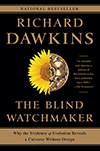 The Blind Watchmaker
The Blind Watchmaker
by Richard Dawkins
-
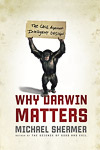 Why Darwin Matters: The Case Against Intelligent Design
Why Darwin Matters: The Case Against Intelligent Design
by Michael Shermer
-
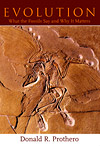 Evolution: What the Fossils Say
Evolution: What the Fossils Say
& Why it Matters
by Donald Prothero
-
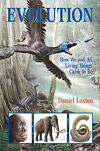 Evolution: How We and All Living Things Came to Be
Evolution: How We and All Living Things Came to Be
by Daniel Loxton
Radiance: The Passion of Marie Curie
November 1 – December 11, 2011
The Geffen Playhouse, Los Angeles, California
ACCLAIMED ACTOR AND WRITER ALAN ALDA as well as Tony Award winner Daniel Sullivan delve into the life and romance of one of the most brilliant female scientists in history. Famous for her groundbreaking research in radioactivity, Marie Curie was the only person ever to win two Nobel Prizes in multiple sciences, but not without a struggle.
For all the answers that come to her in the lab, Curie’s life is peppered with questions of how to realize the passion she has for both knowledge and love. Celebrated but then rejected by the popular press as both a woman and scientist, Curie is left to define her place in society—and history—on her own terms.
The Geffen Invites Kids to Celebrate
the Life and Passion of Madame Curie
November 12 and 19, December 3 and 10 at 11am
The Geffen Playhouse, Los Angeles, California
FOR THE FIRST TIME, the Geffen Playhouse Story Pirates are drawing inspiration from a Geffen Playhouse world-premiere to create a completely original companion piece for kids. Entitled Brilliance!, this science-themed show for kids ages 5–11 is timed perfectly with the run of Alan Alda’s Radiance: The Passion of Marie Curie, the 100th anniversary of Madame Curie’s second Nobel Prize and the first International Year of Chemistry. The Pirate’s Brilliance! is a perfect way to get your kids in on the nerdy science fun!
11-10-26
In this week’s eSkeptic:

Skepticality

Interview with David Daigle
This week on Skepticality, Derek interviews David Daigle, a leading member of the Centers for Disease Control and Prevention (CDC) preparedness team to talk about the CDC’s ‘Be Prepared’ Zombie campaign which has been rolling out since May 2011. Daigle relays information about how the CDC keeps track of upcoming threats to citizens be it a pandemic, food contaminations, and even disastrous massive storms.
MonsterTalk
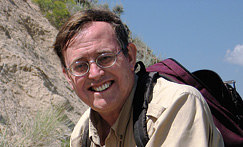
Crypt O’ Zoology:
Dinosaurs in Africa!
From The Lost World to Alley Oop to The Flintstones, the idea of dinosaurs and humans living together has captured the imagination of readers across the globe. But there are some who believe that this idea isn’t fictional. Is there a population of sauropod dinosaurs living in Africa in modern times?
In this episode of MonsterTalk, we interview paleontologist Dr. Donald Prothero at TAM9 about his research into the creature known as Mokele Mbembe! Cryptozoology, paleontology and creationism converge in the jungles of the Congo.

NEW ON MICHAELSHERMER.COM
Transhumanism, the Singularity and Skepticism
Michael Shermer is interviewed about his views on the future of Artificial Intelligence, the technological singularity, transhumanism, and skepticism. This is not something that Michael Shermer usually talks about. Michael also spoke at the Singularity Summit in the US this year (2011). Footage was taken at the 2011 Think Inc conference in Melbourne.
The Decline of Violence
Can anyone seriously argue that violence is in decline? They can, and they do—and they have data, compellingly compiled in a massive 832-page tome by Harvard University social scientist Steven Pinker entitled The Better Angels of Our Nature: Why Violence Has Declined, which Michael Shermer discusses in his October Skeptic column in Scientific American.
Our next lecturer: Daniel Kahneman
Thinking: Fast and Slow
Sunday, November 6, 2011 at 2 pm
Baxter Lecture Hall
THE IDEAS OF THE PRINCETON UNIVERSITY PSYCHOLOGIST DANIEL KAHNEMAN, recipient of the Nobel Prize in Economic Sciences for his seminal work that challenged the rational model of judgment and decision making, have had a profound and widely regarded impact on psychology, economics, business, law and philosophy. Until now, however, he has never brought together his many years of research and thinking in one book. In the highly anticipated Thinking, Fast and Slow, Kahneman introduces the “machinery of the mind.” Two systems drive the way we think and make choices: System One is fast, intuitive, and emotional; System Two is slower, more deliberative, and more logical…
Tickets are first come, first served at the door. Seating is limited. $8 for Skeptics Society members and the JPL/Caltech community, $10 for nonmembers. Your admission fee is a donation that pays for our lecture expenses.

NEW FROM DANIEL LOXTON
ON SKEPTICBLOG.ORG
Ankylosaur Attack Art Demo
from the Vancouver
International Writers Festival
Upon his return from the 2011 Vancouver International Writers Festival, Daniel Loxton shares a peek at the image compositing process used to create the photorealistic dinosaurs in his latest book, Ankylosaur Attack!
JREF Recruits Zombie Horde to Carry Psychic Challenge
Daniel blogs about a recent protest action by our colleagues over at the James Randi Educational Foundation, who enlisted a group of zombies to make a serious consumer protection point. Led by JREF President D.J. Grothe, the undead brought the JREF’s Million Dollar Challenge to alleged spirit medium James Van Praagh.

About this week’s eSkeptic
In this week’s eSkeptic, Harriet Hall, M.D. (a.k.a. the SkepDoc) takes a look at antioxidants. What are they? How do they work? How much is enough? What happens when we ingest more antioxidants than we need? Is the excess excreted? Does it just sit there doing nothing? Does it do something we didn’t intend? And, if they’re so good for us, wouldn’t more of them necessarily be better? Unfortunately, it’s a bit more complicated than that. Find out why. This article appeared in Skeptic magazine volume 16, number 4 (2011).
Antioxidants? It’s a Bit More Complicated
by Harriet Hall, M.D. (a.k.a. the SkepDoc)
I am getting very annoyed with antioxidants. Like Pavlov’s dogs, I’m becoming conditioned to flinch when I hear the word “antioxidant” because it is so often followed by oversimplifications, distortions, and partial truths. The hype is everywhere, in magazines, on the Internet, on the radio, in books, in stores. Antioxidants promise to prevent heart disease, cancer, cataracts, Alzheimer’s, and even wrinkles; they will make you live longer and keep your mind sharp, along with making you feel young again. Well who wouldn’t want that? Every day I am bombarded with recommendations for foods, supplements, and skin creams that are “a good source of antioxidants,” “high in antioxidants,” or “anti-aging” products. Everyone knows antioxidants are wonderful. Everyone except for skeptical scientists who realize it’s a bit more complicated than that.
Antioxidants prevent oxidation. Oxidation is the process whereby oxygen atoms combine with other substances. When oxygen combines with iron, we call it rust. So what is “rusting” in our bodies? Free radicals or reactive oxygen species (ROS) are molecules or ions that have an unpaired electron that is desperately seeking to complete a pair. Normal metabolism creates free radicals like superoxide and hydroxyl radicals. They are necessary for life; we need them for killing bacteria, for cell signaling processes, and other functions. But since free radicals will react indiscriminately with anything, they can also cause damage, for instance by reacting with DNA to cause mutations. Oxidative stress (an excess of free radicals) has been linked to cancer, heart disease, and many other disorders; but it’s not always entirely clear whether it is a cause, a result, or an innocent bystander that just came along for the ride. Some people think it is accumulated damage from free radicals that makes us grow old and die prematurely; they assume that suppressing the damage with antioxidants would increase our life span.
We need a few free radicals to function properly, but an excess of them can wreak havoc. Our bodies know better than to let havoc reign unchecked. They produce neutralizing enzymes like superoxide dismutase, catalase, and peroxidases to keep the free radical population under control. They make use of the antioxidant vitamins A, C, and E in our food, and they produce metabolites like bilirubin and uric acid with antioxidant properties.
We can do our part to maintain our bodies’ defenses by insuring an adequate dietary intake of nutrients. But can we, should we, do more? How much is enough? Should we take supplements? It’s seductive to think we could improve on nature and prolong our lives. If antioxidants are good, wouldn’t more antioxidants necessarily be better?
Unfortunately, it’s a bit more complicated than that. As Ben Goldacre explains in his book Bad Science,
Human biochemistry is a vast interlocking web. An intervention in one place can have quite unexpected consequences; there are feedback mechanisms, compensatory mechanisms. Rates of change in one localized area can be limited by quite unexpected factors that are entirely remote from what you are altering, and excesses of one thing in one place can distort the usual pathways and flows, to give counterintuitive results.
Darn! Pseudoscience and marketing are so easy and straightforward and black and white; why does real science have to be so difficult?
What happens when we ingest more antioxidants than we need? Is the excess excreted? Does it just sit there doing nothing? Does it do something we didn’t intend? It would be nice to know.
There is good evidence that people who eat more fruits and vegetables are less likely to develop cancer, heart disease, and other ailments—and are likely to live longer. It’s easy to assume that the antioxidants in fruits and vegetables are responsible, but that might not be true. Other components of these foods (such as flavonoids) or the mixture of components in the diet might be responsible. Or maybe people who eat less fruit and vegetables are eating more of something else that causes those diseases.
If antioxidants in food do reduce the incidence of those diseases, it’s only logical to think that antioxidant supplements would reduce the incidence even more. Unfortunately, controlled studies have consistently shown that they either have no effect or make things worse. It’s not the first time reality has rudely intervened to spoil a great idea. Study after study has shown no benefit of antioxidants for heart disease, cancer, Parkinson’s disease, Alzheimer’s disease, or longevity. One study did show that an antioxidant combination slowed the progression of established moderate-to-severe macular degeneration, but more research is needed to confirm those results.
Early observational studies suggested that vitamin E supplements reduced the risk of heart disease. I remember reading a report from a cardiologist back when the enthusiasm was at its height. He and his partners had been blithely prescribing high doses of vitamin E for their patients and taking it themselves. After they and many of their patients developed flu-like symptoms, it finally dawned on them that they were experiencing toxic effects from vitamin E overdose. They cut back on the dosage, but kept using it. Subsequently, better studies showed harm rather than benefit. Subjects taking vitamin E supplements were more likely to develop heart failure.
Antioxidant supplements can cause damage. They can be toxic in high doses, can bind to minerals in the diet and prevent their absorption, and can increase the risk of lung cancer. One study was terminated early because of a 46% higher rate of lung cancer deaths in those taking beta-carotene. Post-menopausal women who took vitamin A supplements had more fractures. Some studies have shown an increase in colorectal adenomas. There are reasons to think antioxidants might interfere with some cancer treatments.
An analysis of 68 trials with a total of nearly a quarter of a million subjects found that antioxidant supplements increased the mortality rate. Some experts think that antioxidant supplements have been adequately tested and found not to help; believers argue that the studies may not have tested the right substances or used the optimal doses.
The “superfood” industry has capitalized on the antioxidant craze. The recipe is simple: Pick a fruit, preferably something exotic and tropical. Claim it is a superfood with unique benefits. Develop a concentrate, a pill, or a mixture with other special ingredients. Advertise it with claims that can sneak by FDA restrictions. Solicit testimonials; make them up if necessary. Get several of your friends to try it so you can claim it is “clinically tested.” Start a multilevel marketing company. Charge exorbitantly high prices. Make big bucks. Noni juice, açaí berry, mangosteen, goji, camu camu; even the less exotic green tea, blueberries and pomegranates have generated fortunes. The superfoods concept involves a fallacy. These fruits don’t offer any benefits that you can’t get from components of a normal healthy diet. The fact that they contain high levels of a nutrient is meaningless, since you can get the same amount by eating more of other foods that contain lower levels. One 650mg Tylenol doesn’t work any better than two 325mg pills.
All kinds of antioxidant supplement mixtures are sold. Each claims unique benefits but supports those claims with testimonials rather than with real evidence. Some depend on a gimmick such as a unique proprietary manufacturing process or better absorption. They may claim a synergistic effect from a certain combination of ingredients, but these claims are never supported by published studies. How did they decide to combine those specific ingredients? Did someone in the company employ intuition or use a dartboard?
One anti-aging product, Protandim, claims to act by a different approach. It “persuades your body to increase its own production of antioxidants” and is alleged to “help prevent free radical damage to your cells thousands of times more effectively than any conventional antioxidant therapy… slowing down the rate of cell aging to the level of a 20 year old.” What’s in it? Milk thistle, bacopa, ashwagandha, green tea extract and turmeric. Hmm…and how exactly does this particular combination persuade your body to increase its production of antioxidants?
How do they know it works? They have a grand total of one study in humans: it showed an increase in a TBARS (ThioBarbituric Acid Reactive Substances) blood test. They have one study showing that it reduced the incidence of skin cancers in mice. They have a couple of other studies in mice and in test tubes. They have zero evidence of clinical effects in humans, much less of extended life span. But they have lots of testimonials and you can sign up to become a distributor.
Be wary of claims based on improvements in lab tests. There are many of these, like TBARS and ORAC (Oxygen Radical Absorbance Capacity) scores; you can even buy a home urine test to measure lipid peroxide levels. The same substance may show either pro-oxidant or anti-oxidant effects, depending on which test you choose. The human body is a more complicated environment than a test tube. None of these in vitro tests have been validated as corresponding to in vivo antioxidant effects or to any clinical benefit. Products with high TBARS levels have not been shown to improve patient outcome by any objective measurements. Vitamin E, which we know is a powerful antioxidant in the body, has a very low ORAC score.
Antioxidants are important for health, but so are free radicals. We need to know a lot more before we can confidently recommend increased antioxidant intake for everyone. The American Heart Association doesn’t recommend taking antioxidant supplements; they’re waiting until better evidence becomes available. For now, they say what Mom said: “Eat your vegetables.” That’s prudent advice for other health reasons too; it’s a slam-dunk.![]()
Skeptical perspectives on alternative and experimental medicine …
-
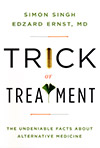 Trick or Treatment: The Undeniable Facts About Alternative Medicine
Trick or Treatment: The Undeniable Facts About Alternative Medicine
by Simon Singh & Edzard Ernst
-
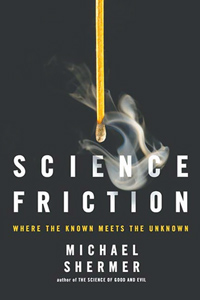 Science Friction: Where the Known
Science Friction: Where the Known
Meets the Unknown
by Michael Shermer
The Better Angels of Our Nature:
Why Violence Has Declined
Why Violence Has Declined
Faced with the ceaseless stream of news about war, crime, and terrorism, one could easily think we live in the most violent age ever seen. Yet as the Harvard University psychologist and New York Times bestselling author Steven Pinker shows in this startling and engaging new work, just the opposite is true: violence has been diminishing for millennia and we may be living in the most peaceful time in our species’ existence. For most of history, war, slavery, infanticide, child abuse, assassinations, pogroms, gruesome punishments, deadly quarrels, and genocide were ordinary features of life. But today, Pinker shows all these forms of violence have dwindled and are widely condemned. How has this happened? This groundbreaking work continues Pinker’s exploration of the essence of human nature, mixing psychology and history to provide a remarkable picture of an increasingly nonviolent world. The key, he explains, is to understand our intrinsic motives—the inner demons and the better angels—and how changing circumstances have allowed our better angels to prevail.
TAGS: Steven Pinker, Why Violence Has Declined“Steven Pinker’s new book, The Better Angels of Our Nature, is one of the most important science books I have ever read, and in my opinion may very well be one of the most important science books ever written. Period. It is a stunning piece of research and an epic masterpiece of narration and storytelling. It is nearly 800 pages long and I’ve already read it twice. It’s that good.”
11-10-19
In this week’s eSkeptic:
Viva Mojave!
JOIN THE SKEPTICS SOCIETY FOR A WONDERFUL THREE-DAY TOUR of the highlights of the Mojave Desert and the Las Vegas area. We will stop at the historic restored ghost town of Calico and take several tours, visit Afton Gorge where Ice Age floods drained Lake Manix, collect 550 million year old trilobites, experience the spectacular boulders of Red Rock Canyon, and conclude with a guided tour of Hoover Dam. The Hoover Dam tours are not recommended for anyone who suffers from claustrophobia, or has a pacemaker or defibrillator. Tours are conducted in confined spaces and in a powerplant with generators emitting electromagnetic frequencies. Those who can not participate in the tour may enjoy the visitor’s center. Each night we will stay at the Excalibur Hotel on the Las Vegas Strip, where you can explore Sin City on your own.
Click an image to enlarge it.
What’s Included?
Tour price includes charter bus, all hotel accommodations, breakfast and lunch each day, guided tour narration and guidebook, all other admission fees, and a tax-deductible contribution to the Skeptics Society. Seats are limited to about 50 people on a single tour bus, so the tour should fill up fast.
Questions?
Email us or call 1-626-794-3119 with a credit card to secure your spot.
Download complete details and registration form for Viva Mojave!
Whale Watching, Geology and Tide Pools
We have about 12 spots left on our 1-day whale watching tour coming up on November 12, 2011. Highlights include: a morning whale watching cruise on a boat reserved just for us, a tour of the Cabrillo Marine Aquarium, a marine biology lecture with special emphasis on tide pools, and a visit to some of the geologic highlights of the Palos Verdes Peninsula (including Portuguese Bend Landslide).
See Steven Pinker this Sunday!
The Better Angels of Our Nature:
Why Violence has Declined
Sunday, October 23, 2011 at 2 pm
BECKMAN AUDITORIUM
“Steven Pinker’s new book, The Better Angels of Our Nature, is one of the most important science books I have ever read, and in my opinion may very well be one of the most important science books ever written. Period. It is a stunning piece of research and an epic masterpiece of narration and storytelling. It is nearly 800 pages long and I’ve already read it twice. It’s that good.”
Harvard University psychologist and New York Times bestselling author Steven Pinker shows in this startling and engaging new work that violence has been diminishing for millennia and that we may be living in the most peaceful time in our species’ existence…
Tickets are $10 Skeptics Society members/Caltech/JPL community; $15 everyone else. Tickets may be purchased in advance through the Caltech ticket office at 1-626-395-4652 or at the door. Ordering tickets ahead of time is strongly recommended. The Caltech ticket office asks that you do not leave a message. Instead call between 12:00 and 5:00 Monday through Friday.

NEW ON MICHAELSHERMER.COM
The Flake Equation
Modelled after the Drake Equation—the famous formula developed by the astronomer Frank Drake for estimating the number of extraterrestrial civilizations—Michael Shermer created the Flake Equation for estimating the number of people we hear about who report having had a paranormal or supernatural experience. Such multiplicative equations for calculating the product of an increasingly restrictive series of fractional values are effective tools for making back-of-the-envelope calculations to solve problems for which we do not have precise data. As you will see, the Flake Equation goes a long way toward explaining why belief in the paranormal and supernatural is so ubiquitous. Experiencing is believing!
The Latest Episode of Mr. Deity: Mr. Deity and the Naughty Bits
WATCH THIS EPISODE | DONATE | NEWSLETTER | FACEBOOK | MrDeity.com

“It is ironic that the United States should have been founded by intellectuals, for throughout most of our political history, the intellectual has been for the most part either an outsider, a servant or a scapegoat.”
An Excerpt from Nonsense on Stilts:
How to Tell Science from Bunk
In this week’s eSkeptic, we present an excerpt from Massimo Pigliucci’s book Nonsense on Stilts: How to Tell Science from Bunk in which he discusses the alleged decline of the public intellectual, especially in the United States, as well as at the parallel ascent and evolution (some would say devolution) of so-called think tanks. He treats both as rather disconcerting indicators of the level of public discourse in general, and of the conflict between science and pseudoscience in particular. It is an area that is both usually neglected within the context of discussing science in the public arena and yet crucial to our understanding of how science is perceived or misperceived by the public. This excerpt appeared in Skeptic magazine volume 16, number 1 (2010).
Science by Think Tank
The Rise of Think Tanks and
the Decline of Public Intellectuals
by Massimo Pigliucci
Are public intellectuals in the 21st century an endangered species or a thriving new breed? Before we can sensibly ask whether public intellectuals are on the ascent, the decline, or something entirely different, we need to agree on what exactly, or even approximately, constitutes a public intellectual. It turns out that this isn’t a simple task and that the picture one gets from the literature on intellectualism depends largely on what sort of people one counts as “public intellectuals,” or, for that matter, what sort of activities count as intellectual to begin with. Nonetheless, some people (usually intellectuals) have actually spent a good deal of time thinking about such matters and have come up with some useful suggestions. For example, in Public Intellectuals: An Endangered Species? Amitai Etzioni quotes the Enlightenment figure Marquis de Condorcet to the effect that intellectuals are people who devote themselves to “the tracking down of prejudices in the hiding places where priests, the schools, the government and all long-established institutions had gathered and protected them.”1 Or perhaps one could go with the view of influential intellectual Edward Said, who said that intellectuals should “question patriotic nationalism, corporate thinking, and a sense of class, racial or gender privilege.”2
Should one feel less romantic (even a bit cynical, perhaps) about the whole idea, one might prefer instead Paul Johnson, who said that “a dozen people picked at random on the street are at least as likely to offer sensible views on moral and political matters as a cross-section of the intelligentsia.”3 Or go with David Carter, who wrote in the Australian Humanities Review that “public intellectuals might be defined as those who see a crisis where others see an event.”4
Regardless of how critical one is of the very idea of public intellectualism, everyone seems to agree that there are a few people out there who embody— for better or worse—what a public intellectual is supposed to be. By far the most often cited example is the controversial linguist and political activist Noam Chomsky. Indeed, his classic article “The Responsibility of Intellectuals,” written in 1963 for the New York Review of Books, is a must-read by anyone interested in the topic, despite its specific focus on the Vietnam War (then again, some sections could have been written during the much more recent second Iraq War, almost without changing a word).5
For Chomsky the basic idea is relatively clear: “Intellectuals are in a position to expose the lies of governments, to analyze actions according to their causes and motives and often hidden intentions…. It is the responsibility of intellectuals to speak the truth and to expose lies.”6 Yet one could argue that it is the responsibility of any citizen in an open society to do just the sort of things that Chomsky says intellectuals ought to do, and indeed I doubt Chomsky would disagree. But he claims that intellectuals are in a special position to do what he suggests. How so? It is not that Chomsky is claiming that only genetically distinct subspecies of human beings possess special reasoning powers allowing them to be particularly incisive critics of social and political issues. Rather, it is that intellectuals—at their best—are more insightful in social criticism because they can afford to devote a lot of time to reading and discussing ideas—something that most people trying to make a living simply do not have the time or energy to do. Moreover, intellectuals have a duty to be so engaged with society because often their vantage point is the result of a privileged position granted them by society, most obviously in the case of academic intellectuals (but also journalists, some artists, and assorted others), who are somewhat shielded from most direct political influence or financial constraints, and whose professional ethos requires intellectual honesty and rigor. Of course, none of this guarantees that public intellectuals always get it right, or that they always further the welfare of society. The classic counter- example, mentioned by Chomsky himself, is the philosopher Martin Heidegger.
Heidegger is a controversial figure, to say the least, both academically and politically (not unlike Chomsky himself, though the similarity ends there). Some commentators consider him one of the greatest of modern philosophers; others think that his writings are full of obfuscatory language and sheer nonsense. He was the mentor of Leo Strauss—who in turn inspired the modern neoconservative movement—as well as the father of several movements that feature prominently in the “culture wars,” such as deconstructionism and postmodernism. At any rate, Heidegger was elected rector of the University of Freiburg in Germany in 1933, under the auspices of the Hitler regime. The inaugural address he delivered is in fact a good example of convoluted nonsense, and it just as clearly represents the exact antithesis of what a public intellectual should be.
After having waxed poetic about spiritual missions and the “essence” of German universities, Heidegger went on to say that “German students are on the march. And whom they are seeking are those leaders through whom they want to elevate their own purpose so that it becomes a grounded, knowing truth,” a rather ominous presage of things to come for the German youth. And he kept going: “Out of the resoluteness of the German students to stand their ground while German destiny is in its most extreme distress comes a will to the essence of the university…. The much-lauded ‘academic freedom’ will be expelled from the German university.”7 Heidegger’s connection with the Nazis will forever taint his legacy, making him a permanent warning to aspiring public intellectuals about what route not to follow.
Chomsky, on the other hand—in a prose infinitely clearer and more compelling than Heidegger’s —raises the question of what the duty of an intellectual ought to be, and answers that she has to be concerned with the creation and analysis of ideologies, including those endorsed or produced by intellectuals themselves. Since the public intellectual, according to Chomsky, has to insist on truth, she also has to see things in their historical perspective, truly to learn from history rather than be bound to repeat the same mistakes over and over. Of course, the whole concept of “truth,” and by implication the efficacy of both science and of intellectual discourse, has been questioned by those academic heirs of Heidegger known as postmodernists. Setting that aside for a moment, however, there are in fact other ways of being skeptical of the whole idea of public intellectualism, for example in the analysis of Richard Posner, author of Public Intellectuals: A Study in Decline.8
Posner was a professor at the University of Chicago Law School and later became a judge on the U.S. Court of Appeals (Seventh Circuit), to which he was nominated by President Reagan. By all accounts, Posner is considered a major and influential legal theorist. Despite being a highly regarded intellectual, his analysis of intellectuals as a breed is anything but sympathetic, although he makes several interesting points that we need to consider while attempting to put together a general picture of intellectualism and how it relates to public understanding of science. Posner, by his own account, wrote his book as a result of what he perceived as the low quality of public intellectuals’ commentaries in two high-profile cases in which he was involved: the impeachment hearings of President Clinton and the antitrust case against Microsoft. Posner’s thesis is that there has indeed been a decline of intellectuals in the United States, but that this isn’t a matter of fewer of them being around. On the contrary, the “market” for intellectualism has allegedly increased dramatically in recent years, but the quality of the individuals populating such a market has decreased sharply.
Posner accounts for this double trend (increase in quantity and decrease in quality) with an ingenious, if certainly debatable, analysis of some of the forces shaping both the supply of and the demand for public intellectuals. On the supply side, intellectuals are now almost exclusively an academic phenomenon. Gone are the days of Zola and (Anatole) France, when it was the independent artist or writer who was more likely to be outspoken about social matters. Instead, the rise of universities (in terms of both numbers and financial resources) after World War II has catalyzed a shift toward academic-type intellectuals. Academics are better positioned than independents to play a role in public discourse because they are more readily perceived as credentialed individuals, and they can afford to stick their neck out about controversial matters in the relative safety of a tenured position.
Not that all is good and well for academics who wish to venture in the public arena. As Posner points out, there are pros and cons that need to be carefully evaluated. On the side of incentives there is the possibility of monetary reward (academic salaries aren’t what they used to be), though it is fairly rare that an academic actually lands a major book contract or is in sufficient demand to command significant honoraria for speaking engagements.
On the side of disincentives, there are several, some potentially career-crippling. To begin with, the more time an academic devotes to speaking and writing for the public, the less time she has to engage in scholarship and research—and it is the latter that gets you tenure and promotions, which helps explain why most public academics are middle aged, post-tenure, and possibly past their intellectual prime. Moreover, the myth of the ivory tower is anything but a myth: despite occasional protestations to the contrary, most academics themselves see engaging the public as a somewhat inferior activity, sought after by people who are vain, in search of money, not particularly brilliant scholars, or all of the above. According to Amitai Etzioni, after his death astronomer and science writer Carl Sagan was referred to as a “cunning careerist” and a “compulsive popularizer”—not exactly encouraging words for other scientists considering following in his footsteps.9
Posner also turns his analysis to the other side of the coin, looking into what sort of demand there might be for public intellectuals. He suggests that there are at least three “goods” that public intellectuals may be “selling,” and that therefore influence the level of “demand” for intellectuals themselves. Besides the obvious one, that is, presumably authoritative opinions on current issues of general relevance, there are what Posner calls “entertainment” and “solidarity” values.
There is little question that we live in a society in which entertainment, broadly defined, reigns supreme. The nightly news, not to mention the 24- hour news channels, are increasingly less about serious journalism and more about sensationalism or soft news, so much so that one can make a not entirely preposterous argument that The Daily Show with Jon Stewart is actually significantly more informative than the real news shows that it is meant to spoof. As biologist Richard Dawkins lamented,10 we think that our kids need to have “fun, fun, fun” rather than, say, experience wonder or interest (they are not the same thing) when going to school or a museum. It is therefore no surprise that even intellectuals have to possess an entertainment value of sorts, although it is of course difficult to quantify it and its effect, if any, on the demand for public intellectuals. Such effect will also depend greatly on the specific media outlet: while there are plenty of TV channels and newspapers for which the entertainment value is probably close to the top of priorities, there are still serious media outlets out there (BBC radio and TV, National Public Radio, Public Television, the New York Times, the Washington Post, The Guardian, The Economist, Slate.com, and Salon.com come to mind, among many others) where the relevance and insight of what the intellectual has to say are paramount.
We come next to the concept of “solidarity value” proposed by Posner. This is often underestimated, but I suspect it does play an increasingly important (and, unfortunately, negative) role in public discourse. The idea is that many, perhaps most, people don’t actually want to be informed, and even less so challenged in their beliefs and worldview. Rather, they want to see a champion defending their preconceived view of the world, a sort of ideological knight in shining armor. Blatantly partisan outlets such as Fox News (on the right), Air America (on the left), and the countless number of Evangelical Christian radio stations are obvious examples of this phenomenon, but perhaps the most subtle and pernicious incarnations of it are all over the Internet. The characteristics of that medium are such that it is exceedingly easy to customize your access so that you will only read what people “on your side” are saying, never to be exposed to a single dissenting viewpoint. While blogs, for example, are indubitably a revolutionary and potentially very powerful way to expand social discourse, it is also very easy to bookmark or subscribe by feed to a subset selected in order to further entrench, rather than challenge, your opinions.
All things considered, Posner’s arguments point toward a level of supply and demand for public intellectuals that translates into a larger number of them than probably at any time in history. But, of course, quantity is rarely an indication of quality, which brings us to Posner’s contention that the decline of the intellectual is a matter of lowered quality. There are fundamentally three reasons for this conclusion, all of which are circumstantial, as it is very hard to assess the quality of public intellectual discourse in any objective and statistically quantifiable way. We have already seen the first reason: since intellectuals are sought after at least in part for their entertainment and solidarity values, and given that neither of these is presumably related at all to the degree of insight offered by the opinions being delivered, quality is liable to suffer.
The second reason advanced by Posner is the inevitable march of academia toward increased specialization of its scholars. Remember that most modern intellectuals are academics, and they are successful within academia because they specialize in incredibly narrow fields of scholarship and research— since most of the broad ones have already been covered exhaustively by their predecessors. For example, the joke used to be that philosophers are people who know nothing about everything (they are intellectual generalists), while scientists know everything about nothing (they are intellectual specialists). But in today’s universities, even philosophers are converging toward the stereotype of the scientist: I know colleagues in philosophy departments who spend a lifetime publishing analyses of the work of just one (usually long-dead) philosopher, and often not a major one at that. Similarly, some of my colleagues in science think it absolutely crucial to invest many hundreds of thousands of dollars and countless graduate-student years to figure out whether an obscure species of mushroom is by any chance found also in Antarctica. This is the way it must work if one wishes to contribute something truly novel to one’s field.
Finally, there is the failure of the so-called marketplace of ideas, which Posner is one of the few to keenly recognize. The phrase originated with Justice Oliver Wendell Holmes, who wrote the dissenting opinion in the infamous Abrams v. United States case argued in 1919 in front of the Supreme Court that was a test of a law passed the year before that made criticism of the U.S. government a criminal offense. The law was upheld, and the statute not invalidated until Brandenburg v. Ohio, during the Vietnam War. Holmes wrote passionately about the safeguard for freedom of speech enshrined in the American Constitution, arguing that “the ultimate good desired is better reached by free trade in ideas—that the best test of truth is the power of the thought to get itself accepted in the competition of the market, and that truth is the only ground upon which [men’s] wishes safely can be carried out. That at any rate is the theory of our Constitution.” Holmes was correct in suggesting that a necessary condition for maximizing our chances to find the truth about whatever subject matter or for reaching a consensus on moral and social issues is to allow ideas to “compete” for people’s minds and hearts.
Posner’s point is that this is by no means a sufficient condition. There is need of a second factor in addition to the free marketplace of ideas, and this is that for the best ideas to win the competition the judges must be, well, competent. But the judges here aren’t indisputable facts that can be verified by anyone; they are the opinions of a generally badly informed and undereducated (with respect to the relevant issues) public. This is a public that has little time for the sort of in-depth analyses and research that would allow it to actually assess the contributions of intellectuals on their merit. Ironically, this is precisely why Chomsky says that it is up to intellectuals, not the public, to do the hard work of research and documentation. The problem, Posner suggests, is that the public tends to go by much less reliable proxies of quality, such as credentials (but, really, it isn’t that difficult to get a Ph.D., even from a reputable university) and the rhetorical abilities of the intellectuals themselves.
There is much to be commended in Posner’s analysis of the decline of the modern intellectual, and yet one cannot help thinking that it is somewhat self-destructive for intellectuals such as Posner to be so critical of their own role in society. A good reality check is a positive and necessary part of public as well as academic discourse, but an exceedingly negative attitude soon breeds contempt for intellectual discourse itself and a nihilistic dismissal of it.
A more positive approach to the analysis of contemporary intellectualism is perhaps provided by Frank Furedi in his Where Have All the Intellectuals Gone? which starts out not with self-criticism, but with ridiculing politicians in charge of public education, namely, the then Labour secretary of state for education in the UK, Charles Clarke. Clarke characterized the idea of education for its own sake—the very foundation of the so-called liberal educational approach common in modern universities—as “dodgy,” which can be interpreted to mean anything from dishonest and unreliable to potentially dangerous. Clarke’s opinion is that the government should not support “the medieval concept of a community of scholars seeking truth.”11 Along similar lines, former U.S. President Ronald Reagan infamously said during his campaign for governor of California in the late 1960s that universities should not subsidize intellectual curiosity.
Of course Furedi is fully cognizant of the fact that a liberal education, just like the idea of a fearless public intellectual, is an ideal and has never corresponded to a historical reality at any point in the past. But it makes a big difference in terms of attitudes and motivations whether we consider an ideal a goal to strive for or we dismiss it as irrelevant, outdated, or even positively dangerous.
While Furedi devotes some space to blaming postmodernism for the decline of intellectualism, a more intriguing observation is that intellectualism is on the retreat just at the time we keep hearing of a “knowledge economy” and when bookstores, book clubs, poetry readings, museums, and galleries are doing increasingly well, to the point of having a single TV show in the United States (The Oprah Winfrey Show) determining which book will become the next overnight bestseller. Yet this apparent paradox is actually explainable by the same distinction that Posner made about intellectuals themselves: quantity does not necessarily translate into quality. While bookstores are increasingly popular, there are basically only two or three major chains left in most parts of the United States (and at least one of them is rumored to be close to bankruptcy), which means that a small number of individuals wields a huge amount of decision power when it comes to which books to promote and which to relegate to the back shelves or even keep out of the store (and, largely, off the market). Winfrey, to her credit, has almost singlehandedly made the rather esoteric and somewhat snobbish idea of a book club one of the most popular activities engaged in by scores of Americans. Then again, some of her picks have been embarrassing, as in the infamous case of James Frey (author of A Million Little Pieces), who turned out to have made up large parts of his allegedly autobiographical story (Winfrey eventually challenged him on her show, but her initial response was that he may have been telling a subjective truth—a perfect postmodernist and nonsensical way of saving face).
Furedi identifies another culprit in the ongoing quest for the disappearance of the public intellectual: the assault on meritocracy. Americans in particular have always had a rather bipolar attitude toward meritocracy: on the one hand, the United States was established by people whose very creed included the idea that it is merit, not birthright, that ought to determine one’s fortunes. American bookstores abound with large sections of books written by successful people telling others how to become successful, and American CEOs and sports figures are lionized because of their merits, not because of their family trees. Then again, one of the reasons Al Gore lost the 2000 presidential election against George W. Bush is because Gore was seen as an “egg-headed intellectual,” obviously an insult, not a compliment.
Furedi’s take is that over the past several decades the very conception of meritocracy has shifted from a powerful incentive paving the way to a fairer society to an intrinsically anti-egalitarian and undemocratic tool of oppression. The reasons for this are many and complex, and they include the rise of new philosophies of teaching within education departments at colleges throughout the nation, as well as the recognition of the sociological fact that certain minorities tend to be at a disadvantage in our meritocratic system as presently constituted (this is not, obviously, a point in favor of biological racism, but a concession to the real difficulties in overcoming cultural conditions and in creating a true level playing field).
Furedi proposes the bold thesis that the currently entrenched rejection of meritocracy is based on two mistaken ideas: first, that a large section of the population is somehow intrinsically incapable of achieving high academic standards; and second, that this failure leads to mental distress, and therefore it is appropriate to substitute “feeling good” for actual results. This is a recipe for disaster, because, as Furedi puts it, “Rewarding merit implies treating people as adults, whereas magicking away the sense of failure is motivated by the desire to treat them as children.”
Think-Tankery: From Intellectualism to Spindoctorism?
Think tanks are now pervasive worldwide: according to Diane Stone, as of the year 2000 there were 4,000 think tanks active in nations across the globe,12 and that number—very likely a gross underestimation— has certainly gone up since. Despite their number and prominent daily presence in the news, there aren’t that many sociological studies of think tanks, and even fewer critical analyses of their role in shaping public opinion. Indeed, there is not much agreement on what, exactly, defines a think tank to begin with.
For the purposes of this discussion, I will use the term “think tank” to refer to a specific kind of organization, namely, a private group, usually but not always privately funded, producing arguments and data aimed at influencing specific sectors of public policy. This definition, therefore, does not apply to most advisory groups established by a given government, nor to university institutes or centers, nor to groups set up to resolve specific problems within the normal operation of a corporation. Although I am generally skeptical of think tanks as a concept, and very critical of the operation of specific ones, I do not mean to imply that all think tanks are useless or pernicious, nor that the general idea cannot in principle be pursued in an honest and constructive fashion. But I am struck by how little critical evaluation of the phenomenon there seems to be, both in the literature on think tanks and more importantly by the media and politicians who are the primary direct consumers of think tanks’ output.
Donald Abelson gives a useful historical perspective on think tanks.13 According to Abelson, the concept went through four relatively distinct phases since its inception about a century ago. The first generation of think tanks appeared in the early 1900s and was the product of the preoccupation of a small number of rich entrepreneurs concerned with the necessity of providing sound, rational advice to the government at a time of increasing complexity of both domestic and foreign policy problems. Thus, people like Carnegie and Rockefeller provided large permanent endowments to these groups, which made them essentially independent from government support (and, therefore, influence) as well as freed them from the necessity of continuously raising private money (again emancipating them from possible leverage by their donors).
That is how groups like the Brookings Institution and the Russell Sage Foundation came about. They operated according to a model of a “university without students,” attracting scholars from across the political spectrum, sharing the ideal (if not necessarily the practice) that reason reaches across ideologies. The results of these efforts were significant in shaping American society during most of the 20th Century, for example, producing a national budget system as well as studies on the causes of warfare.
The second phase of think tank history began after World War II, when the government realized the importance of supporting scientific research because of its obvious relevance to all things military. The National Science Foundation (not a think tank) was established then, and so were think tanks like the RAND (Research and Analysis) Corporation. This is the first worrisome development in the evolution of think-tankery, since it obviously created a direct link between the funding source (in this case the government) and the recipient of research outcomes and policy advice (also the government), thus violating the intentions of the people who established the first think tanks earlier in the century.
Be that as it may, a few decades later we witness another change in concept, with the appearance in the 1970s and 1980s of what Abelson calls “advocacy think tanks.” These are groups like the progressive Institute for Policy Studies and the Center for American Progress, the libertarian Cato Institute, and the conservative Heritage Foundation. These think tanks tend to be significantly smaller than their predecessors, are dependent on continuous support by a large number of relatively small donors, and, more importantly, they often (though not always) blatantly blur the lines between research and advocacy. It is hard to read a “report” from some of these outlets and not think that their “conclusions” were actually the premises from which the whole exercise started, a definite departure from the model of a university—with or without students.
This is apparently an open secret, as the director of a major policy institute told Abelson: “[Think tanks] are tax-exempt cowboys defying the sheriff with their political manipulations. They don’t want to stimulate public dialogue, they’re out to impose their own monologue.”14 Or as Leila Hudson put it: “These institutions have substituted strategy for discipline, ideological litmus tests for peer review, tactics and technology for cultures and history, policy for research and pedagogy, and hypotheticals for empiricals.”15 Another problem intrinsic to the modus operandi of think tanks was best summarized by an anonymous official quoted in an article entitled “On Mediators: Intellectuals and the Ideas Trade in the Knowledge Society,” by Thomas Osborne: “One of the dilemmas of think tankery is that you can either say something sensible, practical and useful and have six civil servants and their dog read it, or you can say something spectacularly silly and have the media cover it.”16 None of these quotes sounds exactly like ringing endorsements of the idea of think tanks.
The last development in think tank evolution is what Abelson calls “vanity think tanks.” These are even smaller and more ephemeral operations, often set up by individuals in pursuit of short-term political goals, like Ross Perot’s United We Stand or Newt Gingrich’s Progress and Freedom Foundation. I will not examine these any further because they are only marginally relevant to science, if at all, although they have demonstrated their ability to affect the outcome of elections, and therefore— indirectly—to influence science funding and education.
What has this to do with science? It is think tanks like the American Enterprise Institute that have the gall to bribe scientists so that they speak critically of reports about global warming, and it is the anti-evolution Discovery Institute, a think tank out of Seattle, that is guided by a mandate founded on “a belief in God-given reason and the permanency of human nature,” rather than on the serious examination of scientific theories such as evolution.
Alina Gildiner goes into some detail about how think-tankery concerning science dovetails into spindoctoring rather than rigorous analysis of the problem at hand.17 Gildiner quotes Laura Jones, whose edited book on risk management has been published by a think tank, the Fraser Institute, as stating—without any data to back the claim up— that “zealous anti-risk activists have heightened our intolerance for small risks,” such as the number of deaths resulting from wheels detaching from transport trucks that were poorly maintained (in Canada, government regulation lowered that number from 215 in 1997 to 86 in 2000, and of course the statistics do not include people who got injured, sometimes seriously, from collisions with the errant wheels). Another “exaggerated risk” discussed by Jones’s authors is the connection between secondhand smoking and cancer. Indeed, the spindoctoring goes so far as taking a judge’s decision to rescind the Environmental Protection Agency’s rule that acknowledged secondhand smoke as a carcinogen— a legalistic decision based on procedural matters— as “evidence” that the claim is scientifically unfounded.
While commenting on another book, written by authors Robert Lichter (president of the think tank Center for Media and Public Affairs and a paid consultant for Fox News) and Stanley Rothman (director of yet another think tank, the Center for the Study of Social and Political Change), Gildiner comments that one would look in vain for nuanced discussions about what should influence public policy. Rather, “what is to be found is a rhetorical, agenda-narrowing usage of scientific language and methods.”18 For example, Lichter and Rothman comment with an authoritative tone on the link between cancer and air and water pollutants, despite the fact that neither one is a scientist and that their sources were almost 20 years out of date. Science progresses; ideologies tend to linger unchanged (and often unquestioned).
One doesn’t really need to read technical articles about think tanks to get a good idea of what many (again, not all) of them are about. Take a look at the Web site of, for example, the Cato Institute (cato.org) and examine their timeline of actions and publications; it speaks for itself. In 1992 they published Sound and Fury: The Science and Politics of Global Warming, in which they state that “there is neither theoretical nor empirical evidence for a catastrophic greenhouse effect and thus no case for what Vice President Al Gore calls a ‘wrenching transformation’ of the American economy.” The following year, they produced Eco-Scam: The False Prophets of Ecological Apocalypse and Apocalypse Not: Science, Economics, and Environmentalism. Jump to 2000 and you will find The Satanic Gases: Clearing the Air about Global Warming. Is there a common thread here?
Or visit the even more obviously slanted site of the Competitive Enterprise Institute, which the Wall Street Journal named (without a trace of irony) “the best environmental think tank in the country.” One of their “scholars,” Robert J. Smith, proudly proposed the rather questionable concept of “free-market environmentalism,” and accordingly CEI was among the first organizations to criticize, back in 1990, the Clean Air Act amendments because they would “impose a new regulatory burden that would lead to higher energy prices” (perhaps, but would they make our air cleaner and our quality of life better?). There is more: CEI in 1992 “advised” the Food and Drug Administration to approve recombinant bovine somatotropin, which is a bioengineered growth hormone. Now surely such a recommendation would be accompanied by the further suggestion of labeling the resulting products so that consumer choice—that ultimate driver of market forces— could be openly exercised? Think again: the CEI argued that mandatory labeling of dairy products is “inappropriate” because it violates the First Amendment (which includes the right to free speech—of the cows?).
In 1996 the CEI folks outdid themselves, launching their Communications Project “with the aim of showing how ‘values-based’ communications strategies can help claim the moral high-ground for our side, by making the case that capitalism is not only efficient, but also fair and moral.”19 If this isn’t a frank admission that the CEI isn’t at all in the business of research but squarely in that of advocacy, it’s hard to imagine what is. Moreover, in 1999 CEI published a monograph arguing that the dumping (not their term) of trash in low-income rural communities in Virginia is actually good for those communities’ economies. One wonders how many fellows of the Competitive Enterprise Institute live in such communities. As recently as 2001 CEI helped persuade the Bush administration (which surely did not need much convincing on this issue) not to regulate carbon dioxide as a pollutant, despite the fact that the gas is universally recognized by scientists as the major contributor to the greenhouse effect. In 2002, CEI won a lawsuit against the FDA in federal court, invalidating the 1998 Pediatric Rule requiring drug companies to test some drugs on children, instead of automatically approving them for use on children if they had passed tests on adults only. To CEI’s evident chagrin, Congress wrote the Pediatric Rule into law.
In this age of global economies, the actions of think tanks of this sort go well beyond national boundaries: in 2003 a CEI fellow sent a letter to the Philippine president, Gloria Macapagal Arroyo, advising her government to “disregard environmental alarmists and to continue allowing Filipino farmers to grow bioengineered corn.” Arroyo followed the suggestion, with apparently no input from her electorate and with predictable financial gains by the bioengineering firms that support CEI’s operations.
Back on national turf, in 2004 CEI exploited the usually high-quality television program Bullshit! with Penn and Teller, normally devoted to debunking the paranormal. The target? Mandatory recycling programs. In the same year, CEI associates argued that living on a McDonald’s diet is good for your cholesterol and that there really is no reason to panic if one finds high levels of lead in one’s water supply (as recently happened in Washington DC).
In 2005 the Competitive Enterprise Institute pushed for opening the Arctic National Wildlife Refuge to oil and gas exploration, which could cause a major environmental disaster with likely little impact on the economics of oil supply, a discussion that once again took front stage during the 2008 American presidential elections. In the same year, CEI filed a challenge to the constitutionality of the 1998 multistate tobacco settlement, while the following year they patted the back of the EPA for allowing human volunteers to be used in studies on the effects of pesticides. Finally, again in a spectacular admission that this think tank is simply not interested in serious research and scholarship, the CEI defended the right of op-ed columnists to be paid by interested parties for the spin they give to their pieces: “An opinion piece—whether an individual op-ed or a column—exists to promote a point of view by argument. It does not seek to establish a fact, but to win people over to a particular viewpoint or opinion.” Indeed, but the reader usually assumes—wrongly, as it turns out—that it is the author’s opinion that one is reading, not that of a government agency or of a private corporation that surreptitiously paid for what superficially looks to the reader like an independent assessment. Caveat emptor!
While there is clear and rather disturbing evidence of an increasing shift from research to advocacy in the sociopolitical phenomenon of think-tankery, how much influence do think tanks really have, and how do they exercise it? Abelson and other researchers have repeatedly pointed out that it is difficult to measure such an elusive property as political and social influence. Attempts have been made to compare one think tank to another based on quantifiable parameters such as the number of press releases they put out that are picked up by major news outlets; the number of media appearances, especially on television, of the think tank’s fellows; and even the number of cabinet-level positions filled by people associated with a given think tank. Of course this scratches only the surface, because political influence can go undetected when it manifests itself as indirectly shaping the views and policies of representatives and senators at both the state and federal levels. When social commentators such as Rush Limbaugh or Bill O’Reilly relate “facts” that they gleaned from thinktank press releases, millions of listeners or viewers will not know or remember the source, only the facts, which may or may not be true. How does one measure that type of think-tank influence?
Obviously, much more research on and critical evaluation of the entire think-tankery phenomenon is needed; meanwhile, the public needs to be wary of the opinions proffered by allegedly unbiased “experts” whose affiliation to think tanks is barely acknowledged by media outlets.
We have analyzed jointly the alleged decline of public intellectualism and the rise of think tanks not because the two are necessarily directly related (though to some extent they may be), but because they both affect the teaching and understanding of science in the public arena, and they both are at the very least symptoms of the kind of transformation of modern society that has had commentators from Postman to Chomsky worried for a long time. Scientists and people genuinely interested in science should be worried too.![]()
References
- In Etzioni A. and A. Bowditch, eds. 2006. Public Intellectuals: an Endangered Species? New York: Rowman & Littlefield, 2.
- Ibid.
- Ibid., 3.
- Car ter, David. 2001. “Public Intellectuals, Book Culture and Civil Society.” Australian Humanities Review, December.
- Chomsky, Noam. 1963. “The Responsibility of Intellectuals.” New York Review of Books, 23 February.
- Ibid.
- Etzioni and Bowditch, Public Intellectuals, 12.
- Posner, Richard. 2003. Public Intellectuals: A Study in Decline. Cambridge: Harvard University Press.
- Etzioni and Bowditch, Public Intellectuals, 12.
- Dawkins, Richard. 1998. Unweaving the Rainbow: Science, Delusion, and the Appetite for Wonder. New York: Mariner Books.
- Furedi, Frank. 2004. Where Have All the Intellectuals Gone? New York: Continuum, 2.
- Stone, D. 2004. “Think Tanks, Policy Advice and Governance,” in Think Tank Traditions: Policy Research and the Politics of Ideas, ed. D. Stone and A. Denham. Machester University Press.
- Abelson, Donald. 2004. “The Business of Ideas: The Think Tank Industry in the USA,” in Think Tank Traditions, 215–29.
- Abelson, “Business of Ideas,” 220.
- Hudson, Leila. 2005. “The New Ivory Towers: Think Tanks, Strategic Studies and ‘Counterrealism’.” Middle East Policy, Winter.
- Osborne, Thomas. 2004. “On Mediators: Intellectuals and the Ideas Trade in the Knowledge Society.” Economy and Society, 4 November.
- Gildiner, Alina. 2004. “Politics Dressed as Science: Two Think Tanks on Environmental Regulation and Health.” Journal of Health, Politics, and Law, April.
- Ibid., 317.
- “About CEI,” at cei.org.
About the Author
MASSIMO PIGLIUCCI is a Professor of Philosophy at the City University of New York and a regular columnist for Skeptical Inquirer and Philosophy Now. In the areas of outreach and critical thinking, Pigliucci has published in Skeptical Inquirer, Philosophy Now, and The Philosopher’s Magazine, among others. He has published over a hundred technical papers and several books. He pens the Rationally Speaking blog, co-hosts the Rationally Speaking podcast, and has authored the popular science book Denying Evolution: Creationism, Scientism and the Nature of Science. His forthcoming book is The Intelligent Person’s Guide to the Meaning of Life (BasicBooks). Check out his author page on Amazon to see his other books.
Skeptical perspectives on intellectuals, human nature, and reason…
-
 Who is Science Writing For?
Who is Science Writing For?
by Margaret Wertheim
-
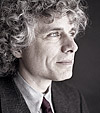 The Blank Slate
The Blank Slate
by Dr. Steven Pinker
-
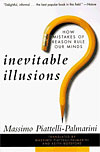 Inevitable Illusions
Inevitable Illusions
by Massimo Piattelli-Palmarini

